NEWSLETTER May/June 2024 | Volume 49, No. 3 IMPROVING HEALTH THROUGH MEDICAL PHYSICS
of PHYSICISTS IN MEDICINE IN THIS ISSUE: ▶ Chair of the Board's Report ▶ ASTRO Update ▶ Art Show 2024 ▶ AAPM Regional Chapter Annual Meeting Highlights ▶ Research Spotlight ▶ AAPM Global Research Mentorship Program Report ...and more! Special Interest Feature: Women's Professional Subcommittee
AAPM
AMERICAN ASSOCIATION

JUNE
17–22 Summer School
Hanover, NH
Deadline to Reserve or Cancel
On-Campus Housing and/or
Registration: May 20
JULY
18–19 TG100, Train the Trainer
Pre-Conference to the Annual Meeting & Exhibition
Registration Open
20 AI for Clinical Medical Physicists
Pre-Conference to the Annual Meeting & Exhibition
Registration Open
2024 AAPM MEETINGS the
JULY
20–21 Review Courses
Pre-Conference to the Annual Meeting & Exhibition
Registration Open
21–25 66th Annual Meeting & Exhibition
Annual Meeting Program
Available Online: May 9
OCTOBER
28–29 Innovations in QA: Moving Toward E cient QA Programs
Virtual
Registration Opens: June 26
EDITORIAL
Jennifer Pursley, PhD, Editor Assistant Professor Massachusetts General Hospital Department of Radiation Oncology 55 Fruit Street Boston, MA 02114 617-643-8273 newsletter@aapm.org
Eileen Cirino, MS Irena Dragojevic, PhD Yanle Hu, PhD
Barbara Lilieholm, MS
Kristen McConnell, PhD Wei Liu, PhD
Joann Prisciandaro, PhD
Anna Rodrigues, PhD
SUBMISSION INFORMATION
To keep all reports uniform, we kindly request that submissions be made through a QuestionPro portal Questions? Contact Nancy Vazquez
PUBLISHING SCHEDULE
The AAPM Newsletter is produced bi-monthly.
Next issue: July/August 2024
Submission Deadline: May 31
Posted Online: Week of July 8
CORPORATE AFFILIATE ADVERTISING
Advertising Rates & Deadlines
CONNECT WITH US!
EDITOR’S NOTE
I welcome all readers to send me any suggestions or comments on any of the articles or features to assist me in making the AAPM Newsletter a more effective and engaging publication and to enhance the overall readership experience. Thank you.
TABLE
AAPM NEWSLETTER is published by the American Association of Physicists in Medicine on a bi-monthly schedule. AAPM is located at 1631 Prince Street, Alexandria, VA 22314 May/June 2024 | Volume 49, No. 3 REPORTS IN THIS ISSUE 5 Newsletter Editor's Report 7 Chair of the Board's Report 11 Executive Director's Report 13 Legislative and Regulatory Affairs Report 15 Updates From ACR HQ 17 ABR Update 19 ASTRO Update 23 Art Show 2024 25 Special Interest Feature: Women's Professional Subcommittee 25 WPSC Events at the AAPM Annual Meeting 26 Update From the Working Group on Equity, Diversity, and Inclusion Committee Outreach and Social Media 27 The Society for Women in Radiation Oncology 28 Book Review 30 Medical Physics at Every Career Level 33 AAPM Regional Chapter Annual Meeting Highlights 35 Research Spotlight 39 AAPM Global Research Mentorship Program Report 43 Person in the News EVENTS/ANNOUNCEMENTS
2024 AAPM Summer School 4 AAPM Specialty Meeting: Innovations in QA 12 Industry Scientists or Regulatory Physicists 16 Our Condolences 22 2024 AAPM Annual Meeting Important Dates 22 2024 AAPM Annual Meeting Pre-Conference Events 24 2024 AAPM Funding Opportunities 24 2025 AAPM Annual Meeting RFP Timeline 29 2024 AAPM Annual Meeting Student and Trainee Events 36 AAPM Committee Classifieds 38 AAPM Speciality Meeting: AI for Clinical Medical Physicists 46 Working Group on Grand Challenges 44 Upcoming AAPM Webinars 45 AAPM Career Services
OF CONTENTS
4
BOARD






Led by Program Directors: Colleen Fox, PhD, DABR, Dartmouth Health • Reshma Munbodh, PhD, DABR, Smilow Cancer Hospital at Saint Francis Hospital
This 4.5-day Summer School aims to provide practical insights into radiation oncology workflows and offer valuable insights on incorporating technology into daily operations. Participants will gain a foundational understanding of operations theory, along with essential skills in project management, change management, and resource management. The program will cover techniques for modeling and monitoring workflows and introduce implementation strategies for cutting-edge tools like auto-contouring, automated planning, and scripting.







AAPM Newsletter | May/June 2024 Volume 49, No. 3 October 28–29, 2024 | Virtual
in QA: Moving Toward Efficient QA Programs AAPM Specialty Meetings
Innovations
REGISTRATION IS OPEN! Early Bird Deadline: May 6 For more information, visit: aapm.me/school
Spring Forward: AAPM’s Focus on the Future
NEWSLETTER EDITOR’S REPORT
Welcome to the May/June 2024 edition of the AAPM Newsletter. There are many informative reports in this issue of the Newsletter, starting with the Chair of the Board report from Ehsan Samei on how the AAPM has revised its position statement on radiation risk and is investing in new strategies of risk communication to better inform patients on weighing risk versus benefit. Executive Director David Gammel’s report focuses on the strategic plan AAPM is developing for 2025-2027, with a draft anticipated in time for the Board meeting at the 66th Annual Meeting & Exhibition in Los Angeles, CA. Speaking of the Annual Meeting, submissions are now open for the second “Art of Scientists Art Show.” We all look forward to enjoying the creativity of our fellow medical physicists!
In this issue, the Special Interest Group feature is from the Women’s Professional Subcommittee (WPSC). Check out their updates, including new social media accounts and interviews with women at one institution during different phases of their careers. Also, learn how the Southwest chapter held a WPSC-style luncheon at their recent annual meeting, which had the theme “Celebrating the Women of SWAAPM.” Hosting AAPM Annual Meeting-style events like the luncheon at chapter meetings is a great way to expand these events to more AAPM members! Other features in this issue include a reflection on the first decade of the Radiation Oncology Incident Learning System (RO-ILS) and a report on the response to the International Council’s first AAPM member questionnaire for potential volunteers for training and education initiatives. Check out the full Newsletter for these reports and more.
We hope every AAPM member finds something of interest in every issue of the Newsletter. All AAPM members are encouraged to submit content and ideas for the Newsletter either directly to the Editor or through the submission link on the Newsletter page. If you have an announcement of an honor or award that you would like to share, please submit it to the Newsletter for consideration. Enjoy this issue of the Newsletter and send us your feedback and ideas for future editions. And as always, please share the Newsletter articles you enjoy with your social media network; the Newsletter is available for all to read. ¢
 Jennifer Pursley, PhD
Jennifer Pursley, PhD
Massachusetts General Hospital
www.aapm.org | 5 AAPM Newsletter | May/June 2024 Volume 49, No. 3
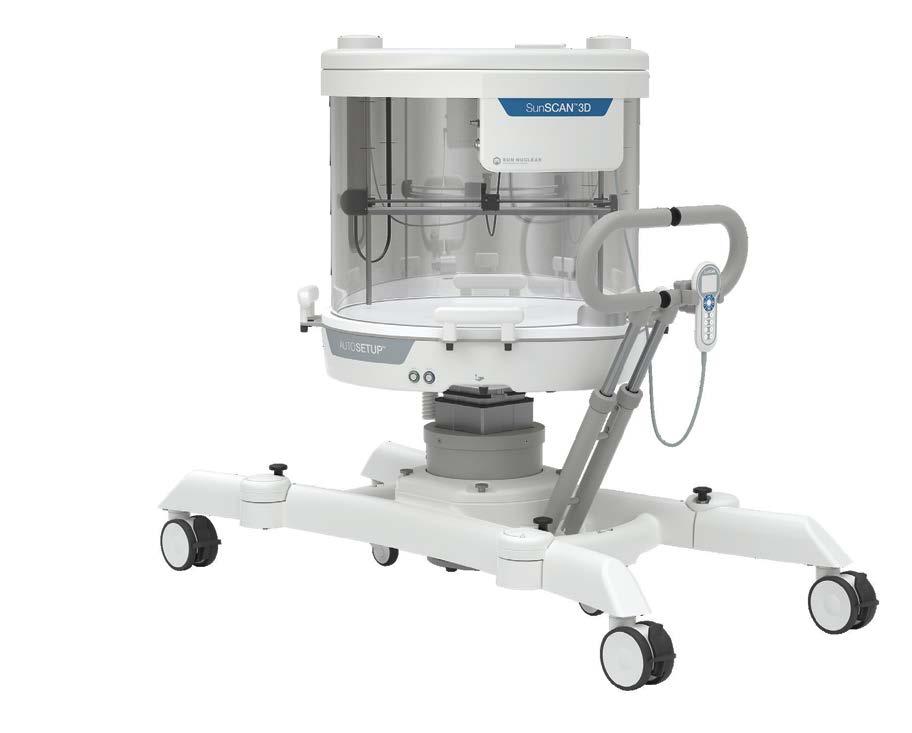



Advanced, Independent SRS & SBRT QA Solutions StereoPHAN™, SRS MapCHECK®, MultiMet-WL Cube SRS MR Distortion Phantom sunnuclear.com Learn more: sunnuclear.com Meet the stringent demands of stereotactic treatments, with our suite of SRS/SBRT solutions. SunSCAN™ 3D Water Scanning System
STEEV™ Phantom
Risk and Quality, Revisited
CHAIR OF THE BOARD'S REPORT
What’s Up with Radiation Risk?
While we continue to seek growth in what we call medical physics, for the majority of its existence, modern medical physics has been preoccupied with radiation – ionizing and non-ionizing, generating it, assessing it, appropriating it, and optimizing it. Historically and practically, we have been and remain experts in the effectual use of radiation in medicine. Radiation is a gift, a precious resource that we brought to medicine — and with it, brought much good in diagnosing and treating a wide array of human maladies. Full stop. Period.
In any form of care intervention, ranging from pills to injections to surgeries, there are often collaterals and side-effects. And for us involved in radiation medicine, one side effect is radiation risk. Does radiation have a risk? Ignorant uses of the past1 and misuses of the present2 certainly indicate so. Medical physicists have been central in minimizing and mitigating this risk so that the benefit would always outweigh the risk. However, prior mishandlings, along with outright abuses3 and public fears of all things “nuclear,” ranging from nuclear fallouts to nuclear accidents to “radiological bombs,” have created an outsized perception of this risk. Our defensiveness in responding to this public perception has not helped either — our inability to speak consistently and unambiguously about this risk implies that there might be something to hide – at a time when the public at large tends to be suspicious of scientific experts (for justified and unjustified reasons a topic for another article).
So, what are we to do? Doing, we certainly need to do, as our profession is and remains preoccupied with radiation. AAPM has taken and is taking three steps towards advancing our approach to radiation risk.
1. A Revised Position Statement
AAPM recently revised its Position Statement (PS-4) on radiation risk. The new version, brought about by group efforts of the AAPM Science Council, Communication Coordination Committee, and Executive Committee, offers a new and more nuanced perspective4. I note the revised content and associated rationales on the following page.
2. A Grant to Upgrade our Risk Communication
AAPM recently received a grant from the American Institute of Physics Venture Fund on radiation risk communication. The grant, led by Anuj Kapadia and Julianne Pollard-Larkin, aims to upgrade our approach to radiation risk communication. Namely, the grant recognizes that there exist different stakeholders in the space, the communication to each of which will require audience-aware strategies. Drawing from decades of insight on risk communication pertained to nuclear power, where there is a substantial gain alongside an uncertain risk, the aim is to curate content that can offer relevant education for each stakeholder group, and empower medical physicists to know how to manage their own uncertainties and yet have a consistent radiation risk message to other care providers and patients.

"It is common in medicine to think of the patient as the ‘subject’ of our care. But in reality, it is the patient that grants us the opportunity to care for them — their agency is central to the very core of medical care."
"The voices, agency, and ownership of these stakeholders are central to the goal of having a quality measure with lasting impact on improving patient care."
www.aapm.org | 7 AAPM Newsletter | May/June 2024 Volume 49, No. 3
Ehsan Samei, PhD Duke University
CHAIR OF THE BOARD'S REPORT , Cont.
Statements in revised PS-4
Paragraph 1
The American Association of Physicists in Medicine (AAPM) unreservedly acknowledges the essential value of imaging in medicine.
Its use, as is the case of any medical procedure, should be clinically justified and optimized, including the use of the appropriate radiation dose necessary to accomplish the intended clinical task.
Medical physicists are essential and qualified professionals who ensure that radiation-related medical procedures are performed at the highest quality and the utmost safety, with properly appropriated dose levels, to maximally benefit patients.
Paragraph 2
There is a theoretical bioeffect associated with any level of radiation dose.
However, at the dose levels properly appropriated for diagnostic imaging procedures, there is no conclusive epidemiological evidence to realize any deleterious effect or unequivocally predict an associated increase in cancer incidence.
Such predictions are subject to significant uncertainty and should not unduly influence the decision for a justified procedure.
The anticipated benefits to the patient from a necessary diagnostic imaging procedure substantially outweigh any potential radiation effect.
Rationales
The statement starts with positive. We don’t do imaging to harm patients, but to benefit them. Patients are better off for having medical imaging as part of their workup.
The statement upfront provides a reminder of the benefit-risk reality of any medical procedure — and that in medical imaging, radiation dose happens to be a specific factor to be considered. The statement further reaffirms the relevance of justification and optimization.
The statement establishes why medical physicists are relevant to all procedures associated with radiation medicine, and play an essential role in optimizing imaging.
Stating unambiguously our current acceptance of the linear no-threshold (LNT) model.
While affirming LNT, we state our limits of knowing and uncertainty in risk characterization at low radiation doses. “Unequivocally” is an important word that aims to faithfully capture the current lack of consensus in the field.
Stating why not accounting our limits of knowing can unintentionally harm patients. The statement further removes the prior dictation on what we consider appropriate for research, and the famed 100 mSv value that was treated by many as a pseud0-threshold — undermining and confusing the need for optimization below that dose value.
Reestablishing again why medical imaging remains an essential net value to patient care.
8 | www.aapm.org AAPM Newsletter | May/June 2024 Volume 49, No. 3
CHAIR OF THE BOARD'S REPORT , Cont.
3. An Award to Honor Patient’s Agency
Third, AAPM was recently received a foundational award on radiation risk5 from the Patient-Centered Outcomes Research Institute (PCORI). Led by myself and Angela Keyser whose role is now taken by our new Executive Director David Gammel, this award is a first on multiple fronts: the first time AAPM has been the direct and sole recipient of an outside award, the first Comparative Effectiveness Research on radiation in medicine, and our first comprehensive work to recognize the primary voice and agency of the patient in radiation medicine. It is common in medicine to think of the patient as the ‘subject’ of our care. But in reality, it is the patient that grants us the opportunity to care for them — their agency is central to the very core of medical care. This award enables a series of listening sessions and focused research on how we can effectively hear, honor, and incorporate patients’ primary agency and voice in radiation medicine. This is a task that is not only the proper ethical thing to do, but further enables the certain potential for improving both the outcome and satisfaction of the medical intervention.
These actions and initiatives underway provide an opportunity to make our understanding, actions, and communications pertaining to radiation risk much more informed, much more relevant, and much more effective, putting our expertise in more effectual service to patient care.
What’s Up with Quality Measures?
When it comes to radiation medicine, managing radiation, in terms of its purposeful and precise use, further informed by patient’s agency, is part and parcel of a deeper mandate that we shall take on: providing effectual care. How can we be certain that we are doing so? How can we gauge the quality of care in radiation medicine in quantitative terms?
1. New CMS Rule, and AAPM’s Response
On April of 2023, CMS proposed a set of electronic quality measures representing the dose and quality of medical imaging examinations in the US. This proposal brought to focus the need for measures to assure the safety, quality, and consistency of medical imaging in practice. While we applaud the CMS’s initiative towards this goal, the new measures raised many challenging questions. Among them, the measures were not based on the
requisite science vetted through rigors of evidence-based medicine. In fact, one of the proposed measures for CT dose was in direct conflict with the AAPM guidelines and the International IEC standards, while another grossly oversimplified image quality based on noise alone from a proprietary algorithm the details of which were opaque at best.
AAPM was proactive in providing feedback on the proposed measures at every opportunity to inform the CMS rule, starting from its first iteration through a National Quality Forum proposal6. Many individual experts selflessly contributed many hours to these AAPM responses, which I gratefully acknowledge here: Dan Bourland, Fred Fahey, Michele Ferenci, Don Frush, Sebastian Gros, Russ Tarver, M Mahesh, and Ioannis Sechopoulos. The concerns raised by AAPM were shared by many of our peer organizations as well. A detailed listing of the AAPM material can be found at this link7:
1. AAPM’s concerns dated April 22, 2022 about the proposed measures as was being considered by the National Quality Forum.
2. AAPM letter to CMS dated June 7, 2023 raising concerns and urging CMS not to adopt the quality measures as proposed.
3. AAPM letter to CMS dated September 5, 2023 raising concerns and urging CMS not to adopt the quality measures as proposed.
4. AAPM letter to CMS dated September 7, 2023 raising concerns and urging CMS not to adopt the quality measures as proposed, or as a minimum a delayed implementation for one year until 2025 to allow limited modification to address concerns.
2. Quality Measures Roundtable — A First
To properly use radiation in medicine there are many stakeholders. The voices, agency, and ownership of these stakeholders are central to the goal of having a quality measure with lasting impact on improving patient care. Thus, concurrent with shorter-term communications listed above, AAPM convened a roundtable on quality measures at the AAPM Headquarters on October 20, 2023. This was a summit that brought together a broad spectrum of 20 medical, scientific, governmental, and industrial stakeholders. The participants included the following:
www.aapm.org | 9 AAPM Newsletter | May/June 2024 Volume 49, No. 3
CHAIR OF THE BOARD'S REPORT , Cont.
Participants of the October 20, 2023 Quality Measures Roundtable
1. American Association of Physicists in Medicine
2. Medical Imaging and Technology Alliance
3. American Association of Physicists in Medicine
4. National Institute of Biomedical Imaging and Bioengineering
5. The Joint Commission
6. Food and Drug Administration
7. American College of Radiology
8. American Society for Radiation Oncology
9. Conference of Radiation Control Program Directors
10. Image Wisely
11. Agency for Healthcare Research and Quality
12. Intersocietal Accreditation Commission
13. Health Physics Society
14. Centers for Medicare and Medicaid Services
15. National Council on Radiation Protection and Measurements
16. American Society for Radiologic Technologists
17. American College of Cardiology
18. Society for Imaging Informatics in Medicine
19. Image Gently Alliance
20. Radiological Society of North America
The roundtable aimed to form a broad consensus on how medical imaging quality and safety can be measured and assured. The goal was to take a proactive step building towards defining and appropriating science-based and consensus-based quality measures for all uses of radiation in medicine. The statement is currently under peer-review and expected to be released in the coming months.
3. Intersocietal Panel to Clarify Ambiguities within CMS Rule
With minor changes, some due to AAPM’s feedback, the CMS rule is expected to go into effect in January 20258. Many challenges still remain. In particular, many imaging practitioners have found ambiguities in the proposed rule, the interpretations of which can significantly impact its
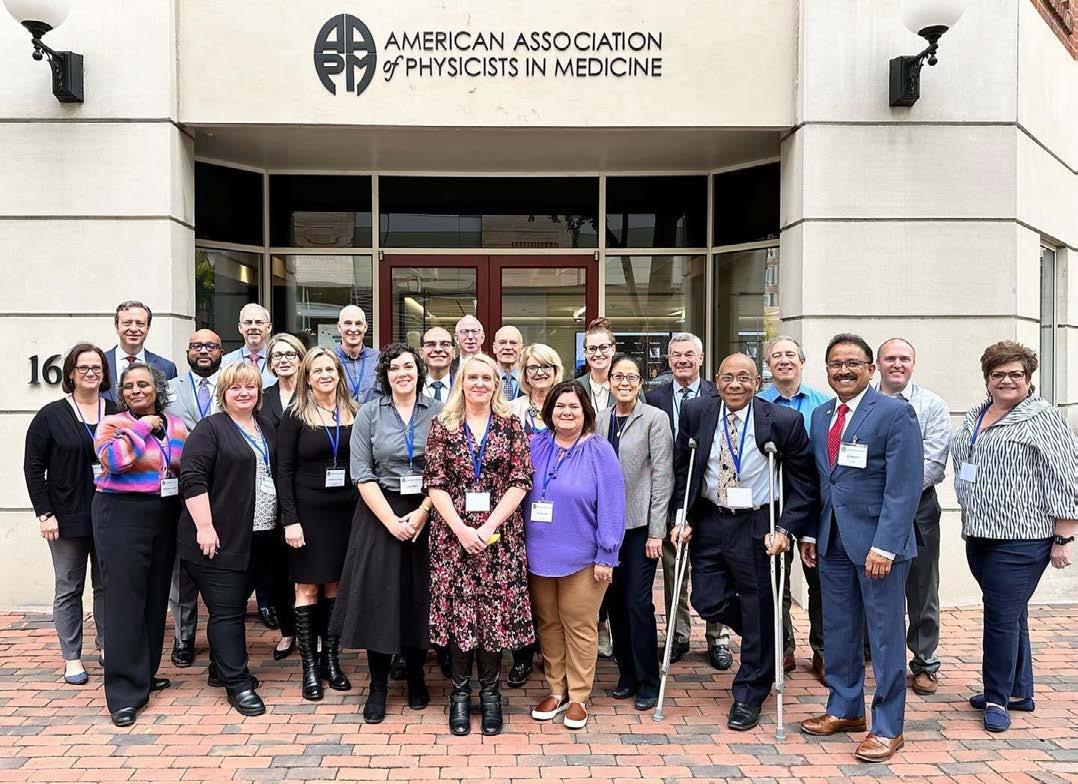
Participants of the First Quality Measures Roundtable at the AAPM Headquarters on October 20, 2023.
implementation. To help with implementation, in January of this year, AAPM commissioned an intersocietal panel of experienced, practical, and committed experts in CT radiation dose, image quality, and patient care including industry representatives, clinical practitioners, and academicians. The panel, including Kirsten Boedeker, Olav Christianson, Eric Gingold, Dustin Gress, Jurgen Jacobs, Michael McNitt-Gray, Lifeng Yu, Jered Wells, and myself, consolidated a list of these ambiguities and provided educated interpretations and recommendations for each identified ambiguity. The work is nearly complete and expected to be released in the near future.
Please be on the lookout for the reports of these two activities. These efforts help us to take full ownership in not only striving to improve care in radiation medicine, but also having sensible and scientifically-based and practicallyrelevant quantities to assess, target, and monitor success in doing so. ¢
1https://www.ncbi.nlm.nih.gov/pmc/articles/PMC3520298/ 2https://www.nytimes.com/2009/10/16/us/16radiation.html 3https://pubmed.ncbi.nlm.nih.gov/7493803/ 4https://www.aapm.org/org/policies/details. asp?id=3615&type=PS
5https://w3.aapm.org/media/releases/AAPMPressRelease2024FundingAward.pdf
6https://www.qualityforum.org/QPS/3663e
7Consolidated CMS-related documents
8https://ecqi.healthit.gov/ecqm/eh/2025/cms1074v1
10 | www.aapm.org AAPM Newsletter | May/June 2024 Volume 49, No. 3
Navigating the Future: AAPM's Journey Towards a New Strategic Plan
EXECUTIVE DIRECTOR'S REPORT
One of the main tasks I was charged with as I came on board AAPM this year is leading the process to develop a new strategic plan for the Association. I’d like to use this month’s Newsletter to talk a bit about that process, approach, and what you can expect as members.
Good strategy essentially serves as a decision-making framework. It helps guide the organization on how to invest its time, people, and money to achieve certain outcomes. If your strategy doesn’t help make those kinds of decisions, then you have more work to do.
AAPM has the benefit of leveraging a considerable amount of work conducted by the Strategic Planning Committee over the past few years, as well as recent work by groups such as the Ad Hoc Committee on New Science, which gives us all the raw material we need to develop a new strategic plan for AAPM.
Themes from that prior work include exploring and preparing medical physics for developing technologies and treatments, as well as growing into new areas of medicine. Supporting health equity and expanding the medical physicist workforce have also emerged as important areas of potential focus.
Positioning AAPM operations and governance to support the above in a sustainable way is another key theme, easing our governance complexity and establishing a sustainable, balanced operating budget so that we have a strong foundation for future growth and impact.
A strategic plan should define the impact the association wants to have and set time-defined goals and initiatives that contribute to those outcomes, guiding overall planning and operations. Given the recent levels of change and disruption in our environment, 3-year planning horizons have become common. Therefore, this is the time frame we have decided to use for AAPM, with a plan addressing 2025 through 2027.
The Strategic Planning Committee (SPC), chaired by Ehsan Samei, has already met to conduct initial work on the plan and to prepare for a Board of Directors virtual strategy retreat in May. That meeting will engage the Board in defining the major priorities we will pursue and begin to outline initiatives and work that can address our desired outcomes. The SPC will then work on developing a formal draft strategic plan based on the Board’s input and propose a plan for approval at the July Board meeting in Los Angeles. This will allow for our 2025 operational planning and budget to be guided by the new strategy.
As members, you can expect to hear updates from leadership and myself as we progress through this process, develop the final plan, and work on implementation planning. This plan will serve as a useful decision-making framework for AAPM as a whole, as well as for all of our Councils, committees, and other groups to individually identify how they can align and contribute to these priorities with their own ideas and work plans.
While the planning effort is significant, no strategy fails on the whiteboard. It’s when we get to implementation that the real work begins. I’m excited to partner with our leadership, volunteers, and professional staff to map out the exciting future we want to create and work with you all to make it a reality. ¢
 C. David Gammel Executive Director, AAPM HQ
C. David Gammel Executive Director, AAPM HQ
www.aapm.org | 11 AAPM Newsletter | May/June 2024 Volume 49, No. 3
VISIT
aapm.org/memb for more details.
InDustry Scientists or Regulatory Physicists:
As an Industry Scientist or Regulatory Physicist, YOU CAN JOIN AAPM.
Individuals eligible to be an AAPM Full member possess an earned graduate degree in the Physical or Biological Sciences, Computer Sciences, Mathematical Sciences, or Engineering from a college, university or program accredited by one of the organizations recognized by the Council on Higher Education Accreditation (or its successors), or an equivalent foreign degree. Applicants should also be engaged in clinical care, professional, research, or academic activity related to applications of physics in medicine and biology as well.
As an Industry Scientist or Regulatory Physicist, YOU CAN VOLUNTEER.
AAPM Full Members in good standing are eligible for voting appointments on Committees, Subcommittees, Working Groups, and Task Groups. Many AAPM groups could benefit greatly from the unique perspective an industry scientist or regulatory physicist offers. Explore current volunteer opportunities at w3.aapm.org/ads/committee_classifieds/classifieds.php (member login required).
As an Industry Scientist or Regulatory Physicist, YOU HAVE OPTIONS.
If the Full member class doesn’t apply, consider the General, Associate, or Affiliate member classes, tailored to suit your career stage and qualifications.
State Champions and AAPM Advocacy
LEGISLATIVE AND REGULATORY AFFAIRS REPORT
The State Champions Program is now officially approved and established within the AAPM committee structure, but we still have a lot of work before it is fully operational. To that end, this brief article describes some of the framework, intended functions, and opportunities of the program. The Government and Regulatory Affairs Committee (GRAC) serves as the parent committee to the State Champions Steering Subcommittee (CHAMPSC), which in turn parents the State Champions Working Group (CHAMPWG).
CHAMPSC, the steering subcommittee, will coordinate and lead the state volunteers. Members of this subcommittee will work with the broader AAPM community to ensure the champion volunteers are properly trained, resourced, and focused on the strategic goals of our organization. CHAMPSC will essentially develop an advocacy playbook that can be enacted by the volunteers. This subcommittee will be composed of individuals from GRAC (and relevant GRAC subcommittees), Regional Organization Committee, Subcommittee on Practice Guidelines, and leading representatives from the state champion volunteers.
CHAMPWG will then contain the state champion volunteers. This will make it easier to provide communications and share information between the various champions. At present, our goal is to recruit a couple champion volunteers from each state, with a specific effort to gather folks from varied disciplines (therapy, diagnostic, nuclear medicine, etc.). Over the past year, GRAC began recruiting efforts through the various chapters, calling for members who would be interested in serving on this initiative. So far, we have nearly 75 volunteers across 35 states. Ultimately, we hope to build out this grassroots advocacy network to well over 100 AAPM members.
Anticipated state champion volunteer activities include:
• Building relationships with elected officials and government staff.
• Monitoring state legislative and regulatory environment for impacts to medical physicists.
• Promoting consistent state regulations and standards.
• Acting as a subject matter expert and advocate for the field of medical physics.
• Testifying at Congressional hearings or advisory boards.
• Planning and participating with Congressional visits or hosting local district visits.
• Engaging and networking with various stakeholders to advance positive (or halt negative) legislative and regulatory changes.
Additionally, AAPM leadership is already looking forward to 2025’s Annual Meeting in Washington, DC President-Elect, Dr. Mahesh, envisions a plan of hosting a Capitol Hill Day. This will afford AAPM members a chance to engage
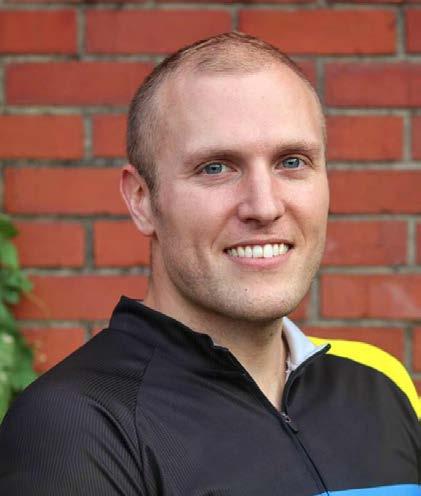 David Crowley Senior Government Relations Manager, AAPM HQ
David Crowley Senior Government Relations Manager, AAPM HQ
www.aapm.org | 13 AAPM Newsletter | May/June 2024 Volume 49, No. 3
LEGISLATIVE
AND REGULATORY AFFAIRS REPORT , Cont.
their Congressional offices, to share about the importance of medical physics, and to advance our top policy objectives at that time. The state champions stand to play a key role in enabling their state delegates for these Hill meetings, and many of them will participate firsthand. The Hill Day for AAPM’s 2025 Annual Meeting is intended to be reproducible, as we aim to build a sustainable model to be utilized in subsequent years.
All said, we are very excited by the opportunities presented by the State Champions Program. Through it, we will dramatically expand our impacts with respect to advocacy and building awareness on the key issues facing medical physicists. Thank you to the members who have already shown an interest and volunteered for the State Champions Program. If you would like to learn more about this program or wish to volunteer, please reach out to me at david@aapm.org ¢
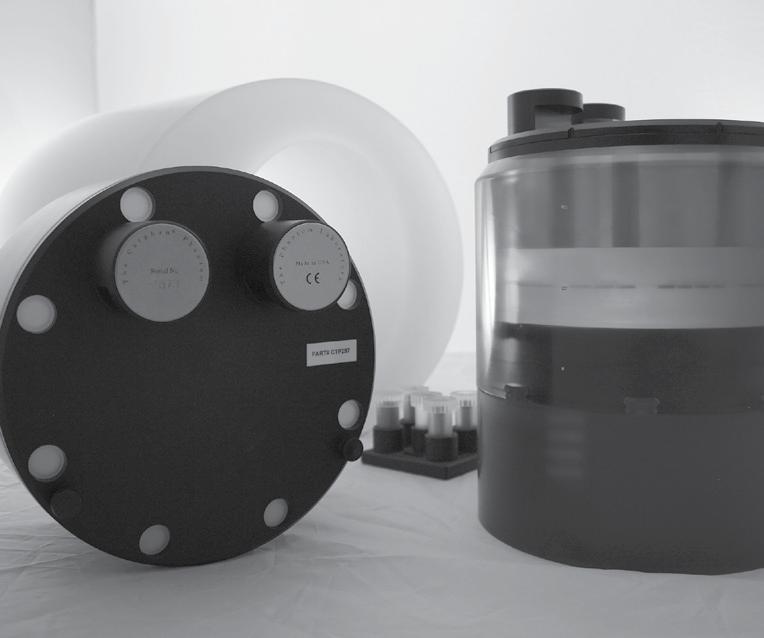
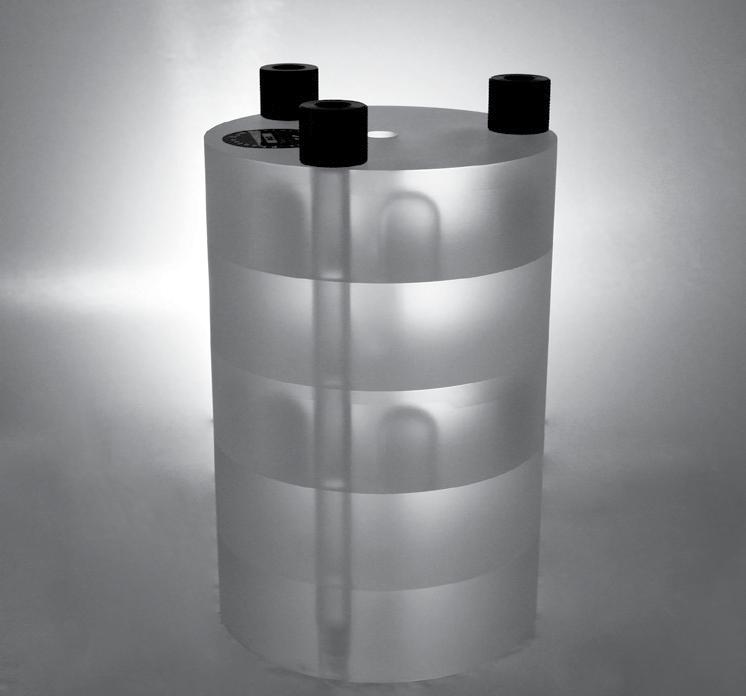

14 | www.aapm.org AAPM Newsletter | May/June 2024 Volume 49, No. 3
Click to see our latest phantoms and request a demo of our Smári image analysis service. Quantitative tests for multi-slice, CBCT, and photon counting scanners coupled with Smári’s critical image quality metrics – engineered for ease of use in the clinical workflow. phantomlab.com Liver Phantom Catphan® 710 Set Corgi™ Phantom PhantomLab CT phantoms – designed to measure the maximum performance of modern scanners.
ACR Accreditation & More: Info for Medical Physicists
UPDATES FROM ACR HQ
Dose Index Registry Update #1: Trauma RPIDs Available for Mapping
Due to the variable nature of trauma CT exams, DIR participants have historically found that trauma exams can “pollute” their routine exam data. ACR has also found that it is widespread practice for an inaccurate patient age to be initially entered due to the emergent nature of the exam; age information can be corrected in the hospital’s EHR and other systems later, but the DIR does not currently have the ability to receive that corrected data. For these reasons the DIR has added the trauma RadLex Playbook IDs for exam name mapping, and the mapping tool has an RPID/Shortname search tool for better user efficiency. This update includes separate reporting and body area definitions for trauma exams. Of course, this benefits DIR participants and the community the most if users all actually map their trauma exams to these trauma RPIDs; please assist your CT clinics and clients in the DIR with appropriately mapping trauma exams. You can always contact ACR NRDR Support with questions.
Dose Index Registry Update #2: Reporting and Analysis Improvements
New CT Administrative Aggregate Report consolidates the Corporate Excel Report and the Facility Excel Report and adds new features
• User access: All NRDR user profiles have access to the report
o Major changes:
The CT Administrative Aggregate Report replaces the Corporate Excel Report and the Facility Excel Report and provides new features, including:
Functionality to compare a single facility to a selected peer group and multiple facilities to one another and the registry
More flexible filter for selecting report timeframe
Filters to select the top 10 exams performed and comparison statistics.
Enhancements to the CT Facility Comparisons Report and the Leapfrog Report
• User access:
o For the CT Facility Comparisons Report: All NRDR user profiles except Corporate Administrator and Service User
o For the Leapfrog Report: All user profiles.
• Major changes to the CT Facility Comparison Report:
o New filters allow for:
Aggregating report data by body area or exam name
Viewing performance by a specific comparison peer group, e.g., location or standing, e.g., above the 75th percentile
Selecting a specific report timeframe and comparing performance against year-to-date or prior-year data
o A new Download dashboard facilitates easier data download.
o Expanded filter options available.
 Dustin A. Gress, MS
Senior Advisor for Medical Physics
Dustin A. Gress, MS
Senior Advisor for Medical Physics
ACR Quality and Safety, Reston, VA
In each issue of this newsletter, I present information of particular importance or relevance for medical physicists. You may also check out the ACR’s accreditation support page for more accreditation information and QC forms. Thank You to all the other staff that keep ACR programs running and assist with creating the content in this column.
In need of continuing education credits? ACR’s Continuous Professional Improvement (CPI) program has an 8-hour physics course, CPI Physics in Imaging Special Edition Module. ACR member price is $159, nonmember price is $329. Be sure to add ACR as one of your Participating Organizations in your CMEgateway.org profile.
www.aapm.org | 15 AAPM Newsletter | May/June 2024 Volume 49, No. 3
UPDATES FROM ACR HQ , Cont.
• Major changes to the Leapfrog Report:
oNew filters allow for:
Drilling down from the Leapfrog summary table to show which RPIDs are used for a given Body Area/ Age Group stratum
Viewing irradiation events for a single exam
Reviewing and removing exams from dashboards
Viewing age group strata that have fewer than 10 exams via color coding
• Accessing the reports:
o For the Facility Comparison Report: Under the DIR Interactive Reports menu heading
o For the Leapfrog Report: In the NRDR Portal access Aggregate Reports under the DIR Interactive Reports menu heading or, in the NRDR main menu, under the Facility Management heading.
See more information on the reporting and analysis enhancements here!
View the DIR Training Webinar Series here!
Dose Index Registry Update #3: TRIAD Site Server is Sunset — Migration to ACR Connect is Required
To get started:
• View the Transition from TRIAD Site Server to DIR Link article where you will find our DIR-Link Installation video and our Transition from TRIAD to DIR Link PowerPoint to lear n about the installation process. This will expedite the time required at the time of installation.
• Based on the infor mation provided in these materials, please determine and notify the individuals who will need to be involved in the installation of ACR Connect (the new site server) and request they review the system specifications here. Please have the appropriate staff members from your IT department install Connect at your site using the ACR Connect Installation Instructions
• If you are having issues during the installation process, please schedule a 30 minute troubleshooting session when the appropriate staff from your team is available.
• After Connect has successfully been installed at your site, we offer two options for activation:
o Your NRDR facility administrator along with your IT department team member can activate Connect at your site without assistance from ACR. Please follow the instructions in the below articles to activate Connect after it has been installed at your site.
Activating DIR Link on ACR Connect
Mapping Scanners in DIR Link
o ACR offers training and assistance for activation on Connect at your site. If you prefer this option, please select a time that works best for your facility administrator and IT team member team using this Calendly URL for Connect/Link activation and training ¢
Our Condolences
Nagalingam Suntharalingam, PhD, FAAPM, FACMP
Our deepest sympathies go out to the family. We will all feel the loss in the Medical Physics community
If you have information on the passing of members, please inform HQ ASAP so that these members can be remembered appropriately. We respectfully request the notification via email to: 2024.aapm@aapm.org (Please include supporting information so that we can take appropriate steps.)
16 | www.aapm.org AAPM Newsletter | May/June 2024 Volume 49, No. 3
Committee Focus: Therapeutic Medical Physics Qualifying Exam Committee
Themission of the ABR is to ‘certify that our diplomates demonstrate the requisite knowledge, skill, and understanding of their disciplines to the benefit of patients.’ For medical physics candidates seeking initial board certification, the ABR accomplishes its mission through the administration of three written qualifying exams followed by a final oral certifying exam. The written qualifying exams consist of two Part 1 exams (general and clinical) and a Part 2 exam specific to the three medical physics disciplines (diagnostic medical physics [DMP], nuclear medical physics [NMP] and therapeutic medical physics [TMP]). To complete the board certification process, a candidate must pass a final oral certifying exam (Part 3) in their discipline. The eligibility requirements and timelines for each exam can be found at theabr.org.
Content for each exam is developed by committees of medical physicist volunteers. Each committee has approximately 10 members who are subject matter experts, along with a chair who is responsible for the committee’s work. An associate chair is selected during the chair’s last year on the committee to ensure a seamless transition to new leadership. A committee is also assigned two ABR staff exam developers who provide administrative support.
Committee members are selected by a Trustee and the Associate Executive Director for medical physics and are appointed initially for a three-year term, with the possibility of re-appointment for an additional three-year term. It is possible for a member to be extended beyond six years on a committee, although this is unusual. Member productivity is assessed annually by the Trustee who oversees the committee. If a committee member is not meeting their goals, the Trustee may reach out to establish the reason and determine whether or not the member has the capacity to improve their productivity during the next writing cycle, or if resignation from the committee is more appropriate.
Committees complete their work during an annual item writing cycle spanning several consecutive months during the year and meet virtually several times during the cycle to review, edit, and ultimately approve questions that are added to each exam’s casebook. An exam is built using both new and previously used questions from the casebook and is reviewed during an endof-cycle in-person meeting attended by committee members and a Trustee. Once approved by the committee, final approval of an exam is provided by a Trustee.
In this article we will highlight the TMP Part 2 qualifying exam committee. This committee is chaired by Leah Schubert and has the following members: Abigail Besemer, Jordan Cutsinger, Anant Gopal, Shyam Jani, Lalith Kumaraswamy, Daniel Letourneau, Leith Rankine, Dennis Stanley, Ranjini Tolakanahalli, Jamone Williams, and Byong Yong Yi. The exam developers assigned to this committee are Casey Sankey and Caitlin Yone.

Matthew Podgorsak, PhD
ABR Board of Trustees Chair Roswell Park Cancer Institute

Robert Pooley, PhD
ABR Trustee Mayo Clinic
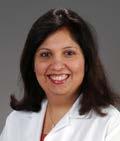
Kalpana Kanal, PhD
ABR Trustee University of Washington

Geoffrey Ibbott, PhD
ABR Associate Executive Director
ABR committees are composed of volunteers who write and review questions for use in subsequent exams. To volunteer for the ABR, click the 'volunteer' button on your myABR web page.
www.aapm.org | 17 AAPM Newsletter | May/June 2024 Volume 49, No. 3
ABR
UPDATE

Committee members in attendance at the August 2023 Exam Creation Meeting at RSNA Headquarters in Chicago. Shown, from left to right, are Dr. Kumaraswamy, Dr. Gutierrez, Dr. Letourneau, Dr. Kruse, Dr. Schubert (committee chair), Dr. Podgorsak (Trustee), Jordan Cutsinger, Dr. Ibbott (Associate Executive Director), Caitlin Yone (exam developer), and Casey Sankey (exam developer). Committee members not shown are Dr. Besemer, Dr. Gopal, Dr. Jani, Dr. Rankine, Dr. Stanley, Dr. Tolakanahalli, Jamone Williams, and Dr. Yi. Drs. Gutierrez and Dr. Kruse( rotated off the committee at the end of 2023).
As indicated by its identifier, this committee develops content for the casebook from which the Part 2 qualifying exam for therapeutic medical physics (TMP) is built. Candidates for this exam are primarily those who have completed a CAMPEP-accredited therapy medical physics residency program, and they generally take this exam for the first time shortly after graduating from their
residency. In selecting committee members from the list of potential volunteers who have applied for and were approved for this role, the Trustees focus on subject matter experts who have close knowledge of the material upon which an exam is based. For this reason, most members of this committee are either program directors or program faculty of therapy medical physics residency programs. The constitution of other committees will be different based on different exam content.
This committee’s work, like all item writing committees, takes place throughout an item writing cycle which lasts several months during the year. Each member is responsible for drafting numerous questions independently and then presenting them for review first to a senior committee member (known as a senior reviewer) and then, during a virtual meeting, to other committee members and the exam developers. Frequently, a draft question undergoes several rounds of review before ultimately being approved to be added to the casebook. The volunteer engagement throughout an item writing cycle is typically many hours of independent work, followed by several committee meetings, and finally a one and one-half day in-person retreat.
We are grateful not only to the members of this committee, but to the members of all medical physics item-writing committees. It would not be possible for the ABR to fulfill its mission without the efforts of the medical physicists who volunteer numerous hours to develop, review, and ultimately approve the questions that the ABR uses to ‘certify that our diplomates demonstrate the requisite knowledge, skill, and understanding of their disciplines to the benefit of patients.’ ¢
18 | www.aapm.org AAPM Newsletter | May/June 2024 Volume 49, No. 3
UPDATE , Cont.
ABR
Ten Years of National Incident Learning with RO-ILS
AMERICAN SOCIETY FOR RADIATION ONCOLOGY (ASTRO) UPDATE
Introduction: The Origins of the RO-ILS system
June 2024 will mark 10 years of operations for the RO-ILS: Radiation Oncology Incident Learning System®. This anniversary invites us to look back at the origins and evolution of the system, which has enjoyed strong support from AAPM and its members.
The RO-ILS system had its beginnings through an error with an MLC file that resulted in a fatal misadministration of radiation. The radiation oncology community only learned of this event through a report in the New York Times1. The news stories garnered national attention and then-AAPM president, Mike Herman, PhD, along with the American Society for Radiation Oncology (ASTRO) leadership, was called to testify before the U.S. Congress. People wanted action. People in the radiation oncology community asked themselves, “Can we do better?” and, in particular, is there a more effective way for us to share information with each other to improve the quality and safety of radiation delivery2? Enter RO-ILS.
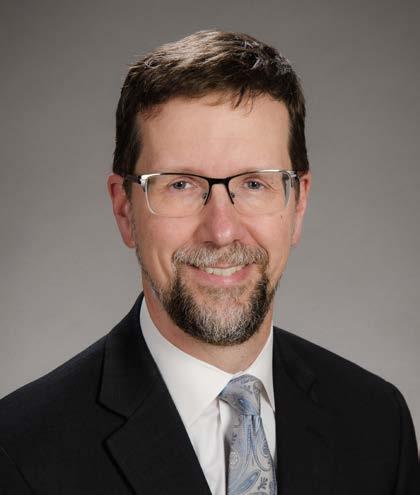

At first it might not seem possible for a hospital or provider to share sensitive quality and safety-related information, especially in the legal and cultural environment of U.S. health care systems. However, radiation oncology was (and is) not alone in the reality of medical errors and the desire to improve the state of health care safety. Not long before the radiation oncology community sought a mechanism to support shared learning, a federal law created patient safety organizations (PSOs) that could collect medical error information in a protected and confidential environment. An effort began, driven by ASTRO, to find an appropriate PSO that might be able to support a national incident learning system for radiation oncology. In parallel, within AAPM there was an effort to define the technical underpinnings of such a system, the results of which were published in 20123. In three short years, with a PSO selected (Clarity Inc.), data elements defined, development work and beta testing complete, RO-ILS was ready to go. In June of 2014, the presidents of ASTRO and AAPM (then John Bayouth, PhD) again went before U.S. congressional representatives to officially launch the program with the mission of facilitating safer and higher-quality care in radiation oncology (Figure 1).

• Program brought to the community by RO-ILS sponsors ASTRO and AAPM.
• Special thanks to RO-ILS supporters Varian, American Society of Radiation Technologists, American Association of Medical Dosimetrists, Sun Nuclear, Radformation, Radiological Imaging Technology, Vision RT and Theragenics.
www.aapm.org | 19 AAPM Newsletter | May/June 2024 Volume 49, No. 3
Eric Ford, PhD University of Washington
Sheri Weintraub, PhD
Southcoast Health
Figure 1: AAPM President John Bayouth, PhD, presenting to U.S. Congressional representatives at the launch of the RO-ILS system, June 2014. (Photo courtesy of John Bayouth, PhD)
Evolution of RO-ILS and Distinguishing Features
The potential for RO-ILS to drive safety improvement depends largely on widespread participation as well as the volume and quality of submitted information. Since its inception 10 years ago, interest and engagement of radiation oncology facilities around the country have grown steadily (Figure 2). As of March 2024, 873 facilities have signed contracts to participate.
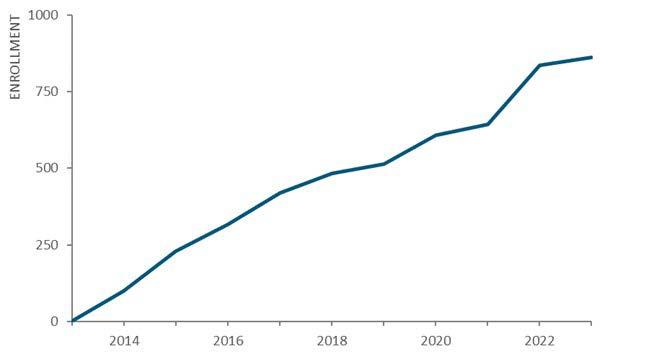
This active engagement is likely driven by multiple factors including the perceived value (a structured incident learning system specifically designed for radiation oncology) and the low barrier of entry (no fees). The program is free to participating facilities, and this is possible because of the sponsorship of organizations including AAPM and ASTRO, and financial supporters (Figure 3). Given the importance of this program for the field, it is surprising more vendors have not aligned themselves with this patient safety initiative.

With growth in participating facilities, the volume of reported events has also increased yearly, except for 2020 when COVID-19 likely paused what would otherwise have been steady growth (Figure 4). As of March 2024, more than 36,000 events have been reported.

Once submitted by participating facilities, RO-ILS events are analyzed by a panel of safety experts who serve on the Radiation Oncology Healthcare Advisory Council (RO-HAC). The RO-HAC is a distinguishing feature of RO-ILS. Many PSOs do not include content experts in this way. The work of the RO-HAC greatly enhances the learning opportunities from the wealth of data in RO-ILS. However, the panel consists of only 12 volunteers working under the PSO umbrella to maintain tight control of the sensitive information. Physicists play a key role in this elite group of interdisciplinary experts with exclusive access to the RO-ILS database, acting as data shepherds. Initially, two RO-HAC members reviewed each event and then this changed to one member per event given the influx of data. To keep up with the growth in report submissions, a triage mechanism was implemented in 2019. The triage protocol identifies cases appropriate for automated review and others requiring a manual review by one of the RO-HAC members.
To continuously optimize potential safety gains from reported information, timely changes have been made within the RO-ILS system. For example, the list of problems used for event characterization has been updated multiple times to better reflect what is being reported. Data submission and analysis tools have also been updated to support improved ease of use.
Output from the RO-ILS system has taken many forms over the past 10 years. Starting with quarterly reports and evolving to multiple educational resources, RO-ILS has released more than 50 educational items to the public (see astro.org/roilsreports). In addition to the safety notice, themed reports have received much attention
20 | www.aapm.org AAPM Newsletter | May/June 2024 Volume 49, No. 3
ASTRO UPDATE , Cont.
Figure 2: Ongoing growth in facility enrollment in RO-ILS
Figure 3: RO-ILS sponsors and supporters
Figure 4: Ongoing growth in annual RO-ILS event reporting
and reached international audiences. Topic selection for themed reports is driven from most commonly reported events which are summarized and presented along with suggested mitigation strategies. Topics have included peer review, surface guidance, equipment quality assurance and training. A peer-reviewed article of common error pathways as seen in high priority RO-ILS events was published in 20184. Finally, there is feedback to vendors. As noted above, some vendors support the RO-ILS program and receive feedback about the safety incidents submitted.
One of the most impactful aspects of incident learning is experience-based information sharing. Stories of near misses, therapeutic incidents and other safety failures are received and then relayed through case studies. This takes the form of reports and well-received users’ meetings hosted at AAPM and ASTRO Annual Meetings over the past 10 years. While preserving anonymity, ROILS data has been used to present reported scenarios through varied publication and presentation forums. This kind of information is highly relatable, and presentations are always accompanied by guidance on related safety practices. The goal is always to afford others an opportunity to proactively address the risk of error.
Another important goal of the RO-ILS program has been to positively impact safety culture. Through information learned and presented, safety environments are understood to be complex and highly impacted by human factors. To shift away from old school “shame and blame” environments toward more productive cultures of safety, RO-ILS has incorporated celebratory components of their outreach. A series of great catch stories were publicized beginning in 2022 and recognition of individuals as safety stars began in 2023. This support and promotion of positive safety cultures is a valued aspect of the RO-ILS program.
Summary
RO-ILS provides a safe, non-punitive environment for sharing information related to quality and safety in radiation oncology. In its first 10 years of operation, RO-ILS has seen steadily increasing usage and engagement, with approximately 40% of facilities in the U.S. now participating. A variety of valuable educational materials have emerged from the program and even though only U.S. facilities can enroll in RO-ILS (since the PSOs operate under U.S. law), the educational materials from RO-ILS are shared freely with the global radiation oncology community. There is hope that in the next 10 years, RO-ILS will see continued growth, hopefully increased vendor support, and further learning opportunities to help facilities deliver high-quality care and keep patients safe. For more information about the RO-ILS program go to the landing page: astro.org/roils. ¢
References
1. Bogdanich W. Radiation Offers New Cures, and Ways to Do Harm. New York, NY: New York Times; 2010: 1.
2. Hendee WR, Herman MG. Improving patient safety in radiation oncology. Med Phys. 2011;38:78–82.
3. Ford EC, de Los F, Santos L, Pawlicki T, Sutlief S, Dunscombe P. Consensus recommendations for incident learning database structures in radiation oncology. Med Phys. 2012;39:7272–7290.
4. Ezzell, G., Chera, B., Dicker, A., Ford, E., Potters, L., Santanam, L., & Weintraub, S. Common error pathways seen in the RO-ILS data that demonstrate opportunities for improving treatment safety. Practical radiation oncology. 2018; 8.2: 123-132.
www.aapm.org | 21 AAPM Newsletter | May/June 2024 Volume 49, No. 3
ASTRO UPDATE , Cont.

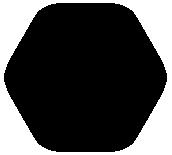

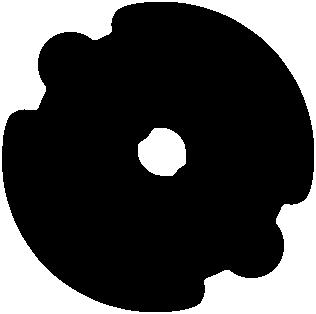
July 20–21 2024 Review Courses July 20 Artificial
MedicalPhysicists July
Train the Trainer Workshop MAY
Annual Meeting Program Available Online
Dead;ome #AAPM2024 IMPORTANT DATES: aapm.me/annual
EventsPRE-CONFERENCE
INtelligence for Clinical
18–19
16:
JUNE 5: Early Bird Registration Deadline JUNE 19: Housing Reservation and Cancel/Receive Refund
The Art of Scientists — 2024
ART SHOW 2024
The 2023 Art of Scientists Art Show, held during the Annual Meeting last year in Houston, TX, gave us an opportunity to connect with the human side of our colleagues through a shared love of art. The Art Show area became a social hub for people to explore common interests, discover the talents of their coworkers, and even spark their personal creativity. I dare say that many new friendships and professional connections may have been formed around it!
This year, we have the opportunity to come together again to enjoy the beauty of our profession and the talents of our community at the 66th Annual Meeting & Exhibition in Los Angeles, CA. Although this year’s show will not include a public poll, a special exhibit is planned as a surprise for all attendees.
We will be accepting submissions of original 2D visual artworks in any physical media (drawing, painting, collage, etc.), with a maximum size of 12 inches by 15 inches, protruding no more than three inches from the backing. Works made using artificial intelligence tools, or suspected to have been made with such tools, will not be considered for exhibition. One entry per AAPM attendee is allowed. Due to space limitations, submissions will be accepted until the available exhibition space is full, based on the time in which the application was submitted.
All works must include their respective mounting hardware and other materials required for hanging the artwork. Further hanging instructions will be provided by the organizers to the authors of the accepted works.
All artists will be responsible for transporting the artwork to and from the Art Show. The care and protection of the artworks are the responsibility of their respective authors. AAPM and the individuals organizing the Art Show are not responsible for any damage that may occur to the artworks during the Art Show or during the transport of the works. All artworks and submissions must abide by the AAPM Code of Ethics.
Submissions will be accepted via Google Forms starting on May 1, 2024 via this link: https://forms.gle/CHw21xaKqYEnbVWGA. The submission form closes on May 19, or when all available exhibition spaces are filled. Accepted entries will be announced to the respective authors via email. Further inquiries may be directed to artofscientistsaapm@gmail.com ¢
 Mariela A. Porras-Chaverri, PhD
Mariela A. Porras-Chaverri, PhD
University of Costa Rica
www.aapm.org | 23 AAPM Newsletter | May/June 2024 Volume 49, No. 3

AAPM/RSNA Imaging Physics Residency Grant
The purpose of the AAPM funding is to provide 50% support of a resident’s salary for two imaging physics residency programs for two years. The awardee institution(s) will provide the other 50% support. Applicants must be a member of AAPM at the time of application (any membership category).
View additional information and access the online application »
AAPM Best Award
Best Medical will provide a $500 stipend to be used for travel, food and lodging expenses to attend in person the 2024 Annual Meeting in Los Angeles. AAPM will provide complimentary 2024 Annual Meeting registration for each recipient, including social functions. Applicants must be an AAPM Associate or Associate-Student member; and first author on an accepted abstract for the 2024 AAPM Annual Meeting. View additional information and access the online application »
APPLY NOW! Application Deadlines: May 15

AAPM2025
67th Annual Meeting & Exhibition | July 27–31 | Washington, DC In 2025 AAPM will be planning earlier for the Annual Meeting Program! The RFP will now open August 27, 2024
RFP Opens Tuesday, August 27, 2024
RFP Closes Thursday, October 10, 2024
Abstract Submission Site Opens for Proffered Abstract Submissions Tuesday, November 5, 2024
Deadline for Proffered Abstract Submissions Tuesday, January 14, 2025
Authors Notified of Presentation Disposition Thursday, April 24, 2025 Online Meeting Program Goes Live Friday, May 9, 2025
NEW!

Special Interest Feature: Women's Professional Subcommittee
WPSC EVENTS AT THE AAPM ANNUAL MEETING
Jennifer Pursley, PhD | Chair of the WPSC | Massachusetts General Hospital
TheWPSC has several events planned for the AAPM 2024 66th Annual Meeting & Exhibition in Los Angeles, July 21-25, and is looking forward to seeing many members there! While the program of committee meetings is still under development, the WPSC will request a meeting on Saturday, July 20, at 4pm. WPSC meetings, both in-person and virtual, are open to all AAPM members to sit in as guests, and the Annual Meeting is a great opportunity to meet some of the members of WPSC and learn about the work of our dedicated group of volunteers.
The WPSC-hosted Women Physicist Lunch is also back for 2024! The Lunch is always held on Tuesday during the meeting, so this year it will be on Tuesday, July 23, at 12:15 pm. Members can register for the Lunch when they register for the Annual Meeting. This Lunch sells out every year, despite increasing the size to over 300 attendees, so register early! The WPSC Lunch has always been self-supported through registration fees, member donations, and generous sponsorship from
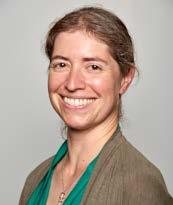
vendors who recognize the importance of supporting this event. Every year the format of the Lunch varies, with options ranging from an invited speaker to a panel discussion to guided table discussions. This year’s format is still being finalized but is likely to include a panel discussion with the speakers in the WPSC-organized session held immediately preceding the Lunch.
Whether or not you can make it to the WPSC Lunch, please check out the Professional Track session organized by the WPSC entitled “Bridging the Leadership Gap: Increasing Representation of Women in Leadership Roles in Medical Physics.” This session will occur immediately before the Lunch, on Tuesday, July 23,
from 11:15–12:15 pm. We’ve gathered a fantastic line-up of speakers who will share their insights on why increasing representation of women in leadership matters, the challenges women face in attaining leadership roles, strategies that institutions can implement to help close the leadership gap, and actions women can take to prepare themselves for leadership roles. We expect there to be a lively Q&A for this session which will transition into continued discussion on these topics in the WPSC Lunch.
Please contact any committee member for more information about these events or other activities of the WPSC. We look forward to seeing many new and familiar faces at the WPSC events at this year’s AAPM Annual Meeting! ¢
The WPSC-hosted Women Physicist Lunch is always held on Tuesday during the meeting, so this year it will be on Tuesday, July 23, at 12:15 pm. Members can register for the Lunch when they register for the Annual Meeting. This Lunch sells out every year, despite increasing the size to over 300 attendees, so register early!
www.aapm.org | 25 AAPM Newsletter | May/June 2024 Volume 49, No. 3
Special Interest Feature: Women's Professional Subcommittee
UPDATE FROM THE WORKING GROUP ON EQUITY, DIVERSITY, AND INCLUSION COMMITTEE OUTREACH AND SOCIAL MEDIA (WGEDIO)
Jennifer E. Dorand, PhD | ProCure Proton Therapy Center
TheInstagram and X, formerly known as Twitter, accounts of the Women’s Professional Subcommittee (@AAPM_ WPSC) have become more inclusive! Please follow us @AAPM_EDIC on both social media platforms for content highlighting equity, diversity, and inclusion efforts in medical physics and to learn about exciting outreach
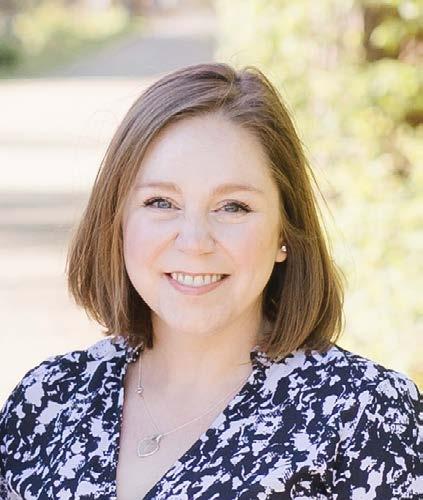



opportunities. Share with anyone you know who might be interested in learning more about medical physics to increase the visibility of our field. The old accounts will be discontinued as we transition to the new handles. Below, meet the faces behind the accounts. ¢
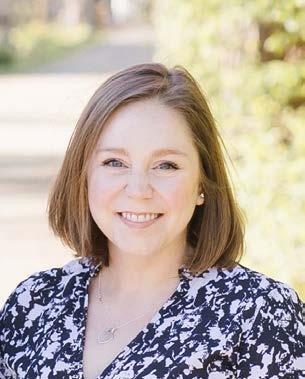
If you have ideas for posts or suggestions for content you would like to see more of, please reach out to our working group at 2024.wgedio@aapm.org
26 | www.aapm.org AAPM Newsletter | May/June 2024 Volume 49, No. 3
Deon M. Dick, PhD, Jaeger Corporation
Dominic A. Maes, PhD, University of Washington
X/Twitter Instagram
Jennifer E. Dorand, PhD, ProCure Proton Therapy Center
Maria Jose Medrano Matamoros, PhD Stanford University
Special Interest Feature: Women's Professional Subcommittee
THE SOCIETY FOR WOMEN IN RADIATION ONCOLOGY
Emily Draeger, PhD | Yale School of Medicine
The Society for Women in Radiation Oncology (or SWRO) is a newer radiation oncology society that was established in 2017. The SWRO was formed to give women and gender monitories a platform in the field of radiation oncology, providing networking, mentoring, and research opportunities, as well as a space to focus on career development within the field.
The main objectives of SWRO are to improve gender equity and inclusion in radiation oncology through:
• Advocating for empowerment of women and gender minorities
• Building community through social media, networking events, and conferences
• Providing mentorship for women and gender minorities throughout training
• Serving as a hub for research on gender and inclusion within the field
SWRO offers mentorship opportunities to physicians and physicists that have or are completing residency, as well as students interested in the fields of radiation oncology and medical physics. Anyone can apply to be a mentor or mentee, and groups are
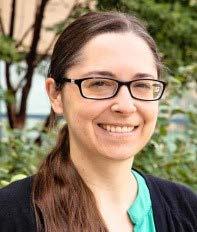
encouraged to meet at least twice per year to discuss training, resources, and career advancement within the field. Along with mentoring, SWRO offers webinars on various topics including interviewing, negotiations, and leadership, as well as social and networking events at national meetings (including ASTRO and ACRO).
Other active committees within SWRO include Communications, DEI (Diversity, Equity, and Inclusion), Advocacy, Physics, and Events & Outreach. The Communications committee works to distribute SWRO material on their website, blog, and social media accounts. The DEI committee works to promote DEI within and beyond SWRO and provides guidance on outreach and advocacy efforts to improve
inclusion/recruitment/retention of underrepresented people and communities within the field. The Advocacy committee works to encourage structural changes in medicine through advocacy for policies that promote wellbeing, positive/inclusive workplaces, and diversity through recruitment. The Physics committee is working to bring physicists to SWRO and collaborates with the Events & Outreach and DEI committees to organize workshops centered on issues faced by underrepresented groups in the field. Finally, the Events & Outreach committee plans events to promote connection and collaboration within the field for gender minorities and women.
Anyone interested in learning more about SWRO or getting involved can visit https://www. societywomenradiationoncology. com/ for more information.
The SWRO was formed to give women and gender monitories a platform in the field of radiation oncology, providing networking, mentoring, and research opportunities, as well as a space to focus on career development within the field. ¢
www.aapm.org | 27 AAPM Newsletter | May/June 2024 Volume 49, No. 3
Special Interest Feature: Women's Professional Subcommittee
BOOK REVIEW:
“ALL
IN HER HEAD: THE TRUTH AND LIES EARLY MEDICINE TAUGHT US ABOUT WOMEN'S BODIES AND WHY IT MATTERS TODAY” BY
ELIZABETH COMEN, MD
Irena Dragojevic, PhD | University of California, San Diego
All in Her Head: The Truth and Lies Early Medicine Taught Us About Women's Bodies and Why It Matters Today is written by Dr. Elizabeth Comen, an oncologist at Memorial Sloan Kettering and a medical historian. It was published in February of this year, and it has already become a USA Today Bestseller. The book provides a historical overview that is a collective narrative of women’s bodies, treatment of women and their ailments throughout history, and a call to action for a new conversation around women’s health.
While reading news one morning, I came across an interesting article in the New York Times titled “A Brief History of Sexism in Medicine”. I clicked on the link and read the article, which turned out to be a book review of “All in Her Head”. Intrigued by the article, I immediately purchased the book.
It opens with Dr. Komen’s anecdote about one of her patients on the brink of death, apologizing to her for being sweaty. She notes how over decades of her experience as a physician she sees a constant theme emerging: women apologizing for asking questions, for inconveniencing her, for not detecting their own cancer sooner… The list goes on. Dr. Komen sees that as a direct result of centuries of diminishment of women and their health problems by the medical establishment. Her stories about patients who were failed by the healthcare system are heartbreaking.
The book, which consists of 11 chapters, follows the history of women’s health as recorded in
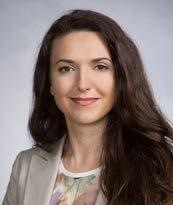
medical literature. Utilizing medical texts, journals, interviews with expert physicians, and her own extensive experience treating women, Dr. Comen navigates through the eleven organ systems, one for each chapter, sharing compelling and previously untold stories. The first chapter, titled Skin, talks about the development of the field of plastic surgery. It initially follows the story of Timmie Jean Lindsey, the first person to get breast augmentation surgery at age 29. She walked into a doctor's office with the intention of getting a tattoo removed and ended up being talked into volunteering to be the first patient to receive breast implants. The book
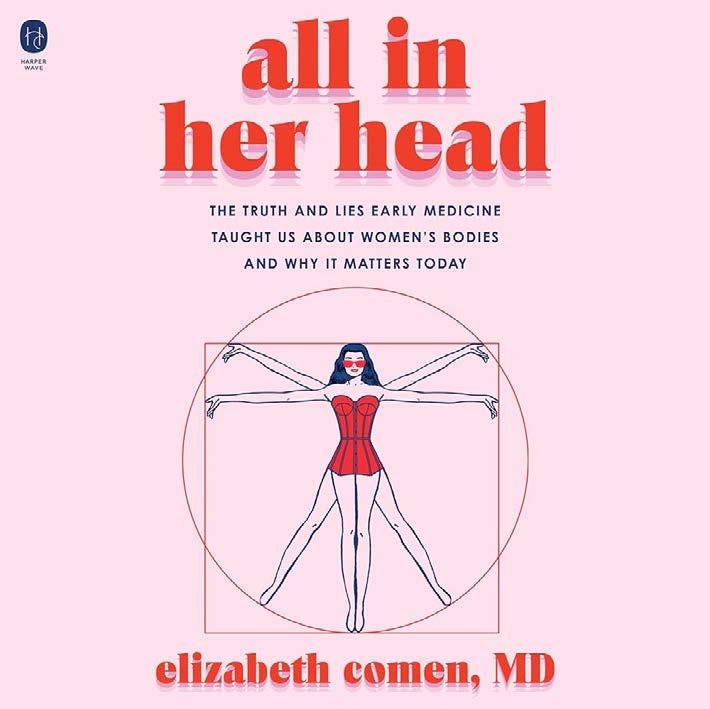
discusses how plastic surgeons often dismiss the concerns that women have and talk them into getting bigger implants than originally wanted or additional procedures. Dr. Komen then talks about her own experience working with breast cancer patients getting mastectomies and how those who choose not to get reconstructive surgery are often pressured to get implants and sometimes have to go to several different doctors to feel heard, causing additional emotional burden on top of a cancer diagnosis.
Throughout the history of women's healthcare, women have frequently been relegated to a voiceless position. The narrative surrounding women's health has primarily been shaped by men who positioned themselves as authorities on the female experience, disregarding the insights, thoughts, fears, pain, and lived experiences of women themselves. This has led to a lasting cultural and societal legacy that still influences the (mis)treatment and care received by women today.
The feeling of not being heard at a doctor’s office is unfortunately something that hardly any woman has not experienced. Even now, women face a higher likelihood of being misdiagnosed compared to men, leading to delayed diagnoses of heart disease and certain cancers. Additionally, they may encounter obstacles in accessing appropriate pain medication, and their symptoms are often dismissed as mere anxiety, reinforcing the notion implied by the book's title that their experiences are all in their head.
28 | www.aapm.org AAPM Newsletter | May/June 2024 Volume 49, No. 3
BOOK
To make the book more practical and not just a lament about the injustices facing women in a medical system, in each chapter of "All in Her Head," Dr. Comen offers practical advice on how to combat the issues. She highlights interviews with physicians who are actively working to improve the healthcare system, particularly by emphasizing the importance of taking female patients' complaints seriously. She encourages patients to trust their own knowledge of their bodies and advocate for themselves effectively. Dr. Comen provides practical tools, such as identifying genuine concerns before appointments and enlisting a trusted person to accompany and support them during medical visits. Additionally, she emphasizes the significance of finding a doctor with whom patients feel comfortable and respected, underscoring that a trusting relationship with a healthcare provider is a fundamental right for every patient.
Even though some of the suggestions in the book are easier said than done – it’s not always that easy to find a new doctor, especially for those that are economically disadvantaged or living in remote areas - they provide a good starting point for female patients. As medical physicists we often interact with patients, and it is important to remember that our role extends beyond medical physics. We are in a unique position that allows us to be advocates not only for ourselves and our colleagues, but also for our patients to make sure their symptoms or complaints are being taken seriously and not dismissed due to bias.
Overall, "All in Her Head" is a remarkable memoir that combines humor, wisdom, and scientific and cultural insights. It is well worth a read!
Throughout the history of women's healthcare, women have frequently been relegated to a voiceless position. The narrative surrounding women's health has primarily been shaped by men who positioned themselves as authorities on the female experience, disregarding the insights, thoughts, fears, pain, and lived experiences of women themselves. This has led to a lasting cultural and societal legacy that still influences the (mis)treatment and care received by women today. ¢

www.aapm.org | 29 AAPM Newsletter | May/June 2024 Volume 49, No. 3
REVIEW , Cont.
#AAPM2024 Get excited for these great STUDENT & TRAINEE EVENTS in Los Angeles this July at AAPM'S 66TH ANNUAL MEETING! • Annual Student Meeting • Student and Trainee Luncheon • Residency Fair • Student Night Out • Expanding Horizons Poster Presentation • MedPhys Slam For more information: aapm.me/annual
Special Interest Feature: Women's Professional Subcommittee
MEDICAL PHYSICS AT EVERY CAREER LEVEL
Jessica Fagerstrom, PhD | University of Washington
For this Newsletter article, I had the pleasure of learning from the experiences of four remarkable women all working in medical physics at a single institution. Each of these physicists is at a different stage of her career, but united by dedication to quality patient care and advancing the field of medical physics.
In this series of interviews, I had the opportunity to hear the diverse and inspiring stories of these women, each of whom offers key medical physics
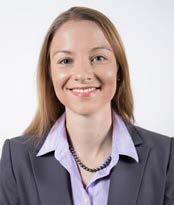
contributions at Emory University. I was fortunate to interview Mandeep Kaur, a graduate of the CAMPEP-
accredited Harvard Medical Physics Certificate Program who is now in her first year of residency at Emory; Krista Burton, a physicist who joined the group in 2023 after completing residency in 2022; Stella Flampouri, an associate professor specializing in proton therapy; and Katja Langen, the Associate Director of the Medical Physics Division and Chief of Proton Physics, a distinguished leader guiding the department to new heights. We discussed their experiences, challenges, and visions for the future.
Mandeep Kaur, PhD
Can you describe your educational background and how you decided to pursue a career in medical physics?
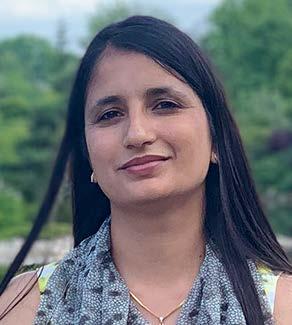
My journey into the world of physics began with a master’s degree in physics, filled with a deep curiosity and a drive to discover. This path led me to a PhD in nuclear physics, where I was fascinated by the study of radioactive nuclei, exploring their properties, and investigating the potential applications they offer. The deep connection between physics and medicine came to light, particularly through the innovative use of rare isotopes when I visited the FRIB lab at Michigan State University. This experience was eye-opening, as I learned about the key role physicists play in healthcare, from developing new diagnostic tools
to advancing cancer treatments. I decided to pursue a career in medical physics after seeing how my nuclear physics background could really help cancer patients.
What experiences have you gained during your residency at Emory University that have prepared you for work after residency?
As a first-year resident of Emory University School of Medicine, I am involved in a research project to develop an innovative and costeffective surface imaging solution for breast radiotherapy, focused on Deep Inspiration Breath Hold (DIBH) monitoring. This advancement is important for clinics with limited resources. Alongside research, my residency includes training in scientific writing, presentations, and teaching. These skills are important for sharing knowledge within the medical community and beyond. Looking ahead, the next two years of my
residency will focus on clinical training, where I will gain hands-on experience in patient care and safety. This comprehensive journey at Emory will shape me into a well-rounded medical physicist.
What are your future career aspirations in medical physics, and how do you plan to achieve them?
As a future medical physicist, I aim to bring innovative changes to healthcare using my expertise in physics. I am driven to enhance the effectiveness and safety of radiation therapy, ensuring better outcomes for patients. My vision is to blend innovative scientific techniques with a deep commitment to patient care, contributing to a future where advanced radiation therapy can improve countless lives. Beyond clinical practice, I am looking forward to teaching and mentoring future medical physicists, sharing my skills and excitement for the field.
30 | www.aapm.org AAPM Newsletter | May/June 2024 Volume 49, No. 3
MEDICAL PHYSICS AT EVERY CAREER LEVEL , Cont.
Krista Burton, MS
What projects are you currently involved in at Emory, and how do they align with your career goals?
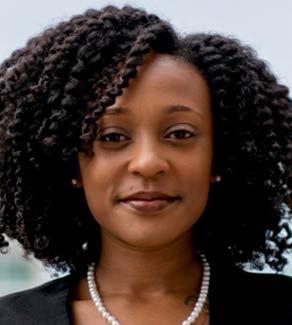
With Emory being a university hospital system, there are a number of unique teaching and mentoring opportunities that are available to medical physicists. Representation is extremely important to me, so over the past few years, I’ve become really interested in mentorship and outreach and being the person I needed at certain points in my life. Since starting with Emory earlier this year, I’ve been able to participate in summer mentorship programs, science festivals and career days. My goal for the future is to develop some type of mentoring partnership between our medical physics department and Atlanta public schools.
What are some of the unique opportunities and challenges you've encountered in your transition to your new role?
Honing in on the education aspect of working for Emory, I have begun teaching the physics class for a radiation therapy school that is offered by another local hospital system. Going from being a student/ resident for so long, to now being the one who is responsible for delivering the information for others to learn has been a really unique experience that I never saw myself encountering.
When you’re a student, it’s like the things you’re supposed to be doing or learning at the moment are outlined for you. When you are the teacher, you are responsible for being organized enough to lay out your own schedule to get things done. It’s just a totally different way of thinking and preparing yourself for success, so I’m figuring out the best way for me to do so.
What advice do you have for women who are starting their first positions post-residency?
My advice would be to navigate the imposter syndrome because you are supposed to be here. Your thoughts and ideas are valid, and they matter. Although certain spaces weren’t necessarily created with you in mind, the future of those spaces can’t exist without you.
Stella Flampouri, PhD
What have been some of the most exciting developments in medical physics that you've been part of at Emory?

I joined Emory in January 2019, a few weeks after the opening of the Emory Proton Therapy Center. Since then, we have treated more than 3500 patients without a defined PTV. All treatment plans are robustly optimized and evaluated. We have developed a state-of-theart motion management program. We are moving from planned dose to patient-received biological dose. The
majority of our current medical physics residents are women.
How can we continue to promote and support women in medical physics, especially those in associate professor positions?
Salary transparency, equal opportunity, and sharing of resources would be a good start. There is a large gender gap in our profession. Slowly, it will go away, but until then, setting and enforcing rules can reduce the presentation of discrimination. Equal pay for the same job, family leave for all, regulated startup funds, internally advertised leadership positions, committees for every decision, etc., all work to promote and support women in medical physics.
What strategies have you employed to maintain a work-life balance while advancing your career in medical physics?
I am a clinical physicist in an academic institution, which is actually more than one job. The clinical part is long and labor-intensive, but what counts for academic promotion is the rest, mainly done after hours. I have a family with three school-age children. There is also pressure to exercise, have a social life, and a hobby. I struggle to fit everything in each day. There are a few things that help me. I do not work remotely; I use commuting to separate work and life. I rely on others; I look for people that I can work with and suggest collaborations. I have a support group of medical physicists, mainly women; these are people who listen and understand.
www.aapm.org | 31 AAPM Newsletter | May/June 2024 Volume 49, No. 3
MEDICAL PHYSICS AT EVERY CAREER LEVEL , Cont.
Katja Langen, PhD
What challenges have you encountered, and how have you overcome them, especially as a woman in a senior position?
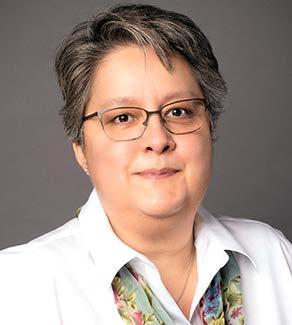
I don’t feel that I personally have encountered challenges that were gender specific. But as a leader it is important to foster a sense of fairness among the team. Women tend to be less direct in their asks and it rests upon leadership to maintain equal access to resources. Being at a department that understands this and strives for equity is immensely helpful.



What strategies have you used to mentor and support the career development of women in medical physics, and what more can be done in this regard?
I hope that I have been a good mentor to both male and female colleagues. However, some women prefer being mentored by other women and it is important that there is a diverse group of available mentors. About 30% of our physics group at Emory consist of women. This creates a very welcoming environment for female, as well as, male colleagues. Similarly, active participation in professional societies is important to foster a sense of belonging for women in medical physics.
Looking forward, what are your thoughts on the future of medical physics and its potential for women, both in academia and leadership positions?
It is great to see many female students and residents entering the field. It is our responsibility to create an environment where all can build a fulfilling career. Each woman who leads a team, teaches graduate students, presents research at an AAPM meeting, or examines at the ABR encourages other women to follow. Over time we will become a profession that mirrors the diversity of our patient population. ¢



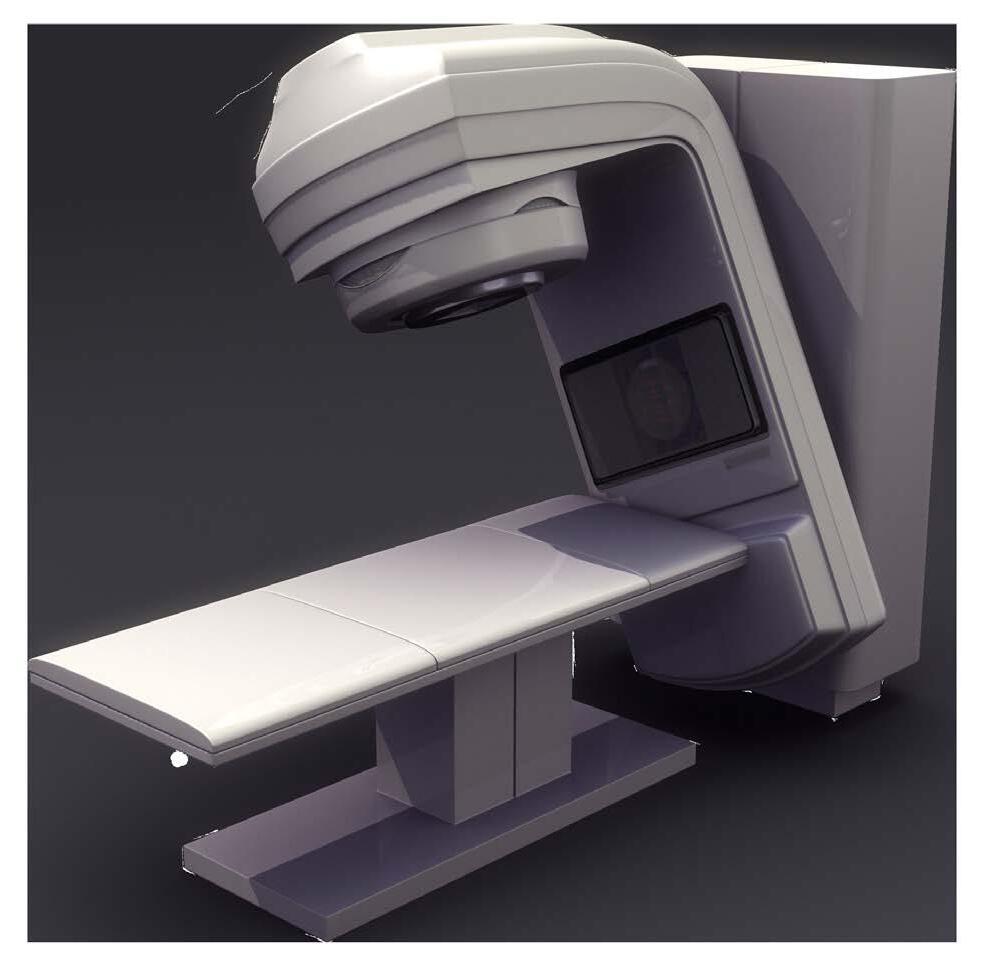

AAPM Newsletter | May/June 2024 Volume 49, No. 3
Southwest Regional Chapter of AAPM (SWAAPM) 2024 Annual Meeting
AAPM REGIONAL CHAPTER ANNUAL MEETING HIGHLIGHTS

TheSouthwest Regional Chapter of the American Association of Physicists in Medicine held their annual meeting on February 15–17, 2024, at the Hard Rock Hotel & Casino in Tulsa, Oklahoma. The meeting theme was “Celebrating the Women of SWAAPM.” This meeting was historic on many fronts — from having around 140 attendees (vendors + members), to having women who were either SWAAPM members or who were educated in the SWAAPM region comprise most of our speakers and session moderators. Prior to the meeting, an online questionnaire was circulated to our women members asking: “What do you want people to know about you?”, “What achievements are you proud of?”, “What are your hobbies?”, and “What is your research or clinical interest?” We received great feedback from our women academic faculty, clinical physicists, residents, and graduate students, which was shared as part of our celebration both on SWAAPM social media accounts and during meeting session breaks.
Our kickoff/icebreaker session on Thursday, February 15 featured a stellar panel comprising Elizabeth Travis, MD, Rebecca Howell, PhD, Kristy Brock, PhD, Rebecca Milman, PhD, Julianne Pollard-Larkin, PhD, and Sara Thrower, PhD discussing, “From Obstacles to Overcoming: Lessons from Women Leaders in Medical Physics.” These remarkable speakers shared their own personal journeys with over 90 session attendees, providing not only advice on how to be a mentor and a sponsor, but also insight on the struggles faced by women in medical physics including competition for research opportunities, competition for funding, and the sometimes problematic gender equity within our field. The session ended with a moving, thought-provoking rendition of the Woody Guthrie song “This Land Is Your Land” performed beautifully by Rebecca Milman, PhD on vocals and banjo with everyone joining in and lending their voices for the finale.
One of the highlights of day two of the meeting was of an amazing workshop led by Ashley Cetnar, PhD, on behalf of the AAPM Committee of Medical Physicists as Educators, titled appropriately, “Medical Physicists as Educators.” This was followed by a great presentation on the Past, Present, and Future of AAPM by the President himself, Todd Pawlicki, PhD. The meeting’s Professional

Arjit Baghwala, MS
Houston Methodist Hospital
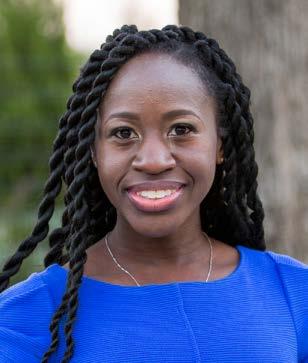
Julianne Pollard-Larkin, PhD
The University of Texas MD Anderson Cancer Center
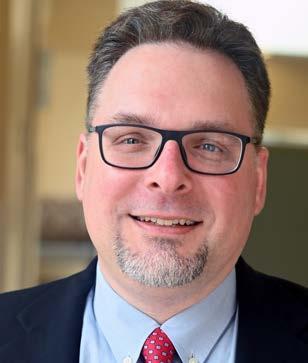
Joseph Dugas, PhD Willis-Knighton Cancer Center
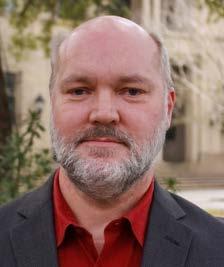
Kenneth (Kip) Matthews, PhD Louisiana State University

Sara Thrower, PhD
The University of Texas MD Anderson Cancer Center
The SWAAPM annual meeting theme was 'Celebrating the Women of SWAAPM’
www.aapm.org | 33 AAPM Newsletter | May/June 2024 Volume 49, No. 3
AAPM REGIONAL CHAPTER ANNUAL MEETING HIGHLIGHTS , Cont.
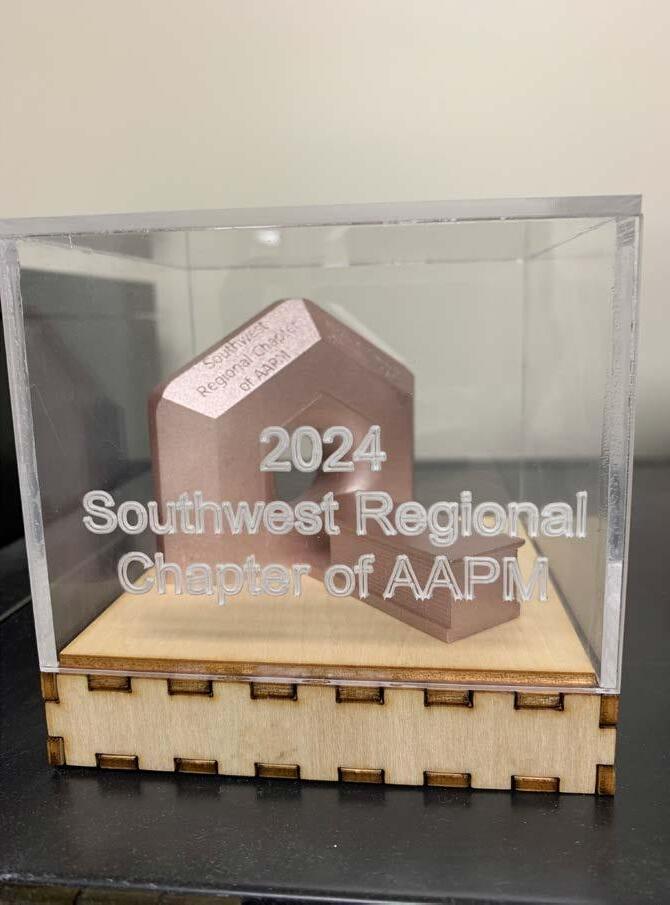
session showcased an amazing panel of speakers discussing the influence of medical physics through AAPM and other national organizations, including Afua Yorke, PhD, speaking on the, “State of Infrastructure, Equipment, and Resources of Radiotherapy Facilities in Africa”; Kenneth “Kip” Matthews, PhD, speaking on the Research Experience for Undergraduates (REU) program and other AAPM initiatives such as the Summer Undergraduate Fellowship Program (SUFP) and the Diversity Recruitment through Education and Mentoring Program (DREAM), and Russell Tarver and Jeffrey Limmer presenting very educational talks on not only how to get involved with AAPM but also addressing the, “what, why, and where to begin” of AAPM service.
In a historical first for AAPM at large, SWAAPM meeting organizers facilitated the first ever AAPM Women Professional Subcommittee (WPSC) style luncheon at a regional chapter with both our member and vendor attendees participating in this extraordinarily well-received event. We were honored to have the chair of WPSC, Jennifer Pursley, PhD, send in a welcome message to our attendees that led us to the luncheon. Our meeting’s second day ended with a graduate student-run “MedPhys Quiz” session where our students used self-developed medical physics questions to pit interdisciplinary, intermingled teams of attendees and industry partners against each other for supremacy (and bragging rights). The spoils of victory included 3D printed models of some of our radiotherapy treatment machines (Halcyons, Ethos, etc.) along with some cool SWAAPM swag. Saturday’s sessions ended with therapy and imaging specific sessions that included topics ranging from whole body MRI to
clinical experience of PET-LINAC and even a talk on eyeplaques.
Among the most notable and emotional moments at this year’s SWAAPM meeting was the presentation of a new SWAAPM chapter award created specifically to recognize outstanding mentorship and sponsorship of the next generation of medical physicists within our region. This first ever SWAAPM mentorship award was presented to Kenneth “Kip” Matthews, PhD, and will be known as the Kenneth “Kip” Matthews Mentorship Award going forward.
Overall, our meeting was a resounding success. We are proud to have had the opportunity to highlight some of the amazing women of SWAAPM while continuing to provide exceptional educational and professional opportunities to our membership. Thank you to everyone who helped us achieve our goal. Please join us for next year’s meeting from February 13–15, 2025, at the Hilton Baton Rouge Capitol Center in Baton Rouge, LA. ¢

34 | www.aapm.org AAPM Newsletter | May/June 2024 Volume 49, No. 3
3D printed Halcyon — SWAAPM swag
Kip Matthews, PhD with the Kip Matthews Mentorship Award presented by SWAAPM President Arjit Baghwala
A look inside the black box: the drive to a more transparent AI
RESEARCH SPOTLIGHT
As the users of artificial intelligence (AI) in medicine seek better understanding of its inner workings, developers—including medical physicists—are advancing new ways to make it more transparent and trustworthy.
AI has arrived in medicine with much hype and promise. In medical physics, AI-based tools can automate time-consuming tasks like contouring and treatment planning and provide automated measures of anatomical and physiological properties. Promising applications like image reconstruction and predictive treatment with deep learning, a sophisticated AI method that uses neural networks in a layered structure designed to resemble the human brain, are helping to reshape clinical workflows in radiation therapy [1][2].
“There are more than 600 FDA-approved products cleared for AI in medicine, and I think that number is going to increase dramatically in the near future, especially with the movement to large language models,” said Lei Xing, PhD, Jacob Haimson & Sarah S. Donaldson Professor and Director of the Medical Physics Division of Radiation Oncology Department at Stanford University in Stanford, CA.
Despite the potential for broader impact, many AI users desire the opportunity to understand or interpret the AI tool beyond a simple numerical or categorical output. The issue is especially acute for the neural networks behind deep learning, which have many layers and non-linear numerical operations involved in their development.
The often-impenetrable processes of medical AI have left regulatory agencies wary. Last year’s Artificial Intelligence Act from the European Union mandated that the decision-making process of high-risk AI systems such as those used in healthcare should be transparent and traceable; in other words, explainable.
“Explainability is an old problem, but the increasing use of AI has made it a very urgent issue,” said Dr. Xing. “Without trustworthiness in AI, we can’t use it for high-stakes applications like clinical decision-making.”
Developers and researchers are working to improve transparency by making the AI more explainable or interpretable. Explainable AI models use a second model to provide a post-hoc explanation of the first black box model, while interpretable models focus on the inner workings of the model itself [3].
Research efforts focus on different points in the process of AI model development and testing. In medical physics, techniques [4] like gradient saliency maps, data dimension reduction and feature visualization, attention mechanism, model architecture design and post-hoc explanation are being explored as ways to provide a look inside the black box.
 Jing Qian, PhD Mayo Clinic
Richard S. Dargan Contributing Writer, AAPM
Jing Qian, PhD Mayo Clinic
Richard S. Dargan Contributing Writer, AAPM
www.aapm.org | 35 AAPM Newsletter | May/June 2024 Volume 49, No. 3
RESEARCH SPOTLIGHT , Cont.


Volunteers are essential to furthering the AAPM mission of advancing medicine through excellence in the science, education, and professional practice of medical physics. Become a part of this dynamic community via the AAPM Commi ee Classifieds. Exciting new opportunities are posted regularly; bookmark or check back o en to explore the latest possibilities to get involved!
“At the model construction phase, we start with some interpretable features so that we can make the model a little bit more transparent to us,” said Xun Jia, PhD, Professor and Chief of the Medical Physics Division of the Department of Radiation Oncology and Molecular Radiation Sciences at Johns Hopkins University in Baltimore, MD.“Once the model is built, we evaluate it from many, many perspectives. It takes a combination of both aspects.”
Explainability can be improved at the beginning of model development through the introduction of domain knowledge directly to the neural network.
Dr. Xing and colleagues developed such an approach using deep learning to capture the myriad interactions among the genes in a cell before feeding the data into the neural network. Images from the gene expression data called genomaps can be used to build predictive models with dramatically improved performance [5]. The casting of these gene-gene interactions into a spatial configuration enables rapid extraction of features that would be impossible or would take months to see with existing methods.
“If you include the gene-gene interactions before dumping the data into the deep neural network, you make the complex data more comprehensible to AI and increase the robustness of the model,” said Dr. Xing. “At the end of the day, this will increase the model’s transparency and trustworthiness.”
The manifold discovery and analysis (MDA) [6] and contrastive feature analysis (CFA) [7] algorithms developed by Xing’s group also represent novel ways to address “the curse of dimensionality,” a problematic phenomenon in which the large number of features available from digital health data reduce the generalizability of robust AI models.
“We came up with a technique that is more sensible,” said Dr. Xing. “It provides an enabling tool for deep learning feature visualization and analysis with substantially improved performance and efficiency, so we don’t see the curse-of-dimensionality problem anymore.”
Using human reasoning to guide model development is another way that developers are working to increase transparency in AI.
36 | www.aapm.org AAPM Newsletter | May/June 2024 Volume 49, No. 3
RESEARCH SPOTLIGHT , Cont.
Dr. Jia and colleagues developed a virtual treatment planner to generate high-quality treatment plans for prostate cancer patients undergoing stereotactic body radiation therapy (SBRT) [8,9]. Using reinforcement learning, an AI method that mimics the human decisionmaking process by self-learning through trial and error, the researchers trained the virtual planner to autonomously operate a commercial treatment planning system in plan optimization.
The virtual planner was found to repeatedly adjust the radiation dose to different organs and structures around the prostate, like a human planner would, until a highquality plan was achieved.
“The first iteration has a reasonable plan, iteration 5 starts to tighten the dose and iteration 13 starts to reduce the dose to the urethra,” said Dr. Jia. “This process is very reasonable to us.”
The virtual planner finished third, when being retrospectively evaluated in the 2016 American Association of Medical Dosimetrist/Radiosurgery Society Plan Study, beating numerous human-created entries. The team also competed with the tool in the 2023 Dosimetry Plan Challenge on a challenging head-and-neck cancer adaptive replanning case and won first place by achieving
References:
satisfactory plan quality in the shortest amount of time.
The goal behind all this work, Dr. Jia said, is not to unpack every step in the AI’s reasoning but to build trustable AI models that are more like human partners. Just as medical physicists build trust with human peers by working with them, so it is with AI.
“It’s not completely necessary to achieve full explainability; probably, it is not possible,” said Dr. Jia. “From an application perspective, you want to build confidence, understand the limitations and know that the human will be the last line of defense.”
That last line of defense will often be a medical physicist. As AI-based algorithms evolve and improve, medical physicists will continue to play a central role in ensuring patient safety and optimal care.
“As medical physicists, we have a great foundation in mathematics and physical science, we have access to data and we have access to a lot of domain knowledge,” said Dr. Xing. “We should be the driving force, not only in medical physics but also in the entire AI field.”
“We need to ensure that whatever the AI model is, we are doing the right things for our patients,” added Dr. Jia. “Safety and quality care are the fundamental goals.” ¢
1. Xing L, Giger ML, Min JK: Artificial Intelligence in Medicine: Technical Basis and Clinical Applications. Academic Press, London, UK, 2020.
2. Valdes G, Xing L, Artificial Intelligence in Radiation Oncology and Biomedical Physics, Taylor & Francis Books, Inc, Boca Raton, FL, 2023.
3. Rudin, C, Stop Explaining Black Box Machine Learning Models for High Stakes Decisions and Use Interpretable Models Instead. arXiv, 2019. 1811.10154.
4. Cui, S., et al., Interpretable artificial intelligence in radiology and radiation oncology. Br J Radiol, 2023. 96(1150): p. 20230142.
5. Islam, M.T. and L. Xing, Cartography of Genomic Interactions Enables Deep Analysis of Single-Cell Expression Data. Nat Commun, 2023. 14(1): p. 679.
6. Islam, M.T., et al., Revealing hidden patterns in deep neural network feature space continuum via manifold learning. Nat Commun, 2023. 14(1): p. 8506.
7. Islam, M.T. and L. Xing, Deciphering the Feature Representation of Deep Neural Networks for High-Performance AI. IEEE Trans Pattern Anal Mach Intell, 2024. PP. DOI: 10.1109/TPAMI.2024.3363642.
8. Shen, C., L. Chen, and X. Jia, A hierarchical deep reinforcement learning framework for intelligent automatic treatment planning of prostate cancer intensity modulated radiation therapy. Phys Med Biol, 2021. 66(13).
9. Gao, Y., et al., Implementation and evaluation of an intelligent automatic treatment planning robot for prostate cancer stereotactic body radiation therapy. Radiother Oncol, 2023. 184: p. 109685.
www.aapm.org | 37 AAPM Newsletter | May/June 2024 Volume 49, No. 3
Visit https://aapm.me/2024AICMP for more information and to register: 2024 AAPM Annual Meeting & Exhibition Pre-Conference Meeting

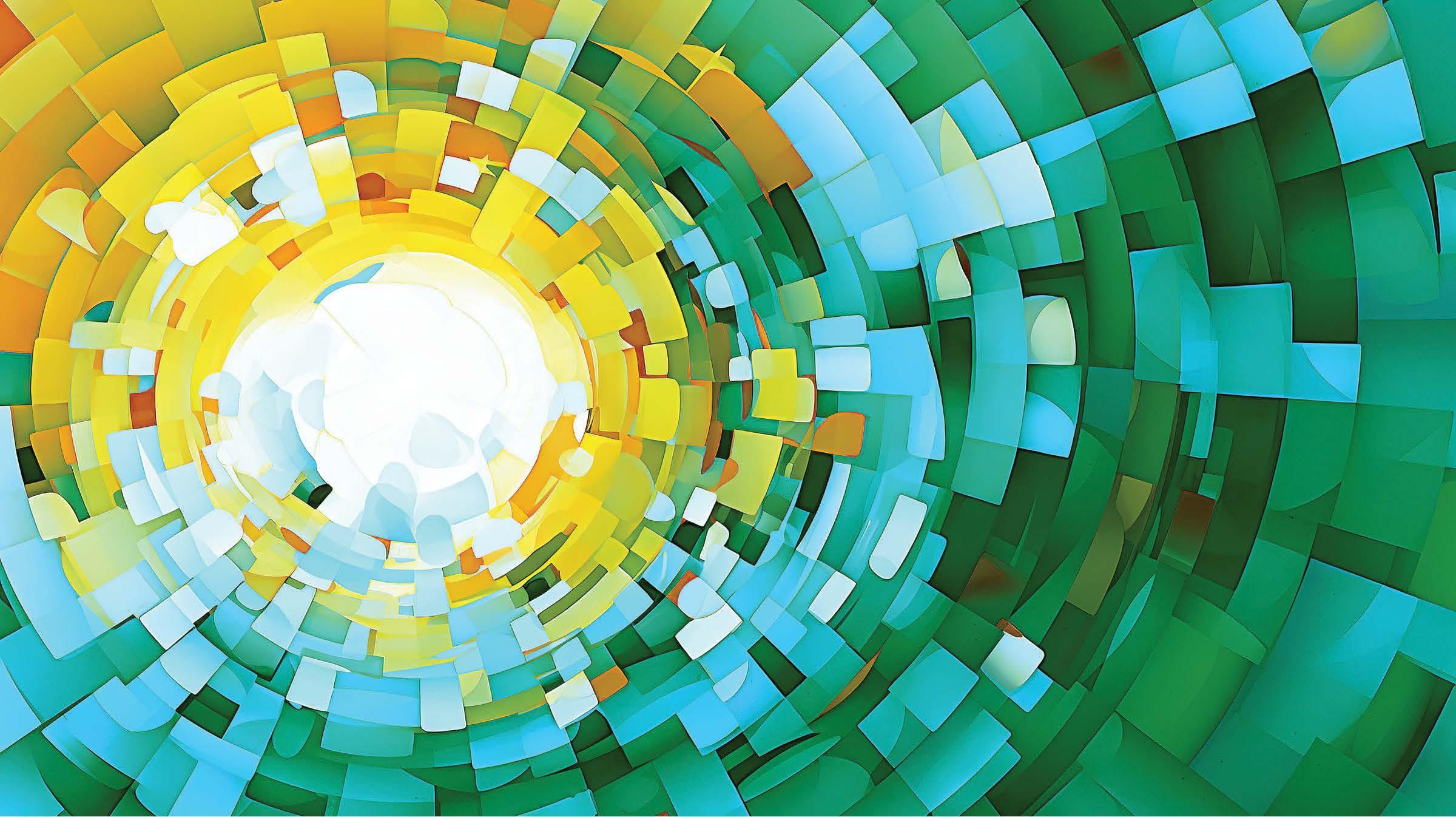
Saturday, July 20, 2024 | 8:00 am – 5:00 pm
Los Angeles Convention Center | Los Angeles, CA
Golden State Hackathon
When the stars come out... the Varian Developer Workshop begins.
Saturday, July 20, 2024 5:30 - 9:00pm Los Angeles Convention Center

https://bit.ly/43JJutx Scan to register and learn more!
Artificial Intelligence for Clinical Medical Physicists
AAPM Specialty Meetings
A Sri Lankan Story
AAPM GLOBAL RESEARCH MENTORSHIP PROGRAM (GREMP) REPORT
My name is Buddhika Srimal Sesath, and I serve as a Medical Physicist at the Teaching Hospital Badulla, Sri Lanka (SL). I completed my honors degree in Physics from the University of Jaffna, SL., followed by a master's degree in medical physics from the University of Colombo, SL. Subsequently, I was fortunate to secure a PhD position at the University of Colombo, where I had the privilege of being supervised by Jeysingam Jeyasugiththan, PhD, a Senior Lecturer in Medical Physics in the Department of Nuclear Science, University of Colombo, N. Jeyakumaran, MD, a Consultant Oncologist at the National Cancer Institute Maharagama, SL, and Krishni Wijesooriya, PhD, an external mentor at the University of Virginia, VA, USA.
My PhD title is “Utilizing radiomics and biodata to predict treatment efficiency in H&N Cancers”. The main objective of this research is to utilize radiomics to predict treatment efficiency in Head and Neck (H&N) cancers at various radiation oncology clinics across Sri Lanka, connecting with biodata. Currently, there is a wide disparity in healthcare between high-income countries (HIC) and low- to middle-income countries (LMICs). The high costs of many therapies and bio-makers developed in HICs render them nonimplementable in LMICs. Therefore, research conducted in high-income countries fails to address issues that are prevalent in LMICs. Hence, it is important that LMICs conduct their own research to come up with solutions that are feasible, effective, and implementable in their regions. Extracting, harmonizing radiomic features from planning CTs of radiotherapy to predict the success of a treatment or when to discontinue the treatment to reduce toxicity, if successful, is a low-cost application that fits the needs of LMICs.
This study will investigate the radiomic features of pre- and post-CT images, in conjunction with biodata, to correlate with treatment outcomes and predict overall survival for Sri Lankan subjects. Treatment responses and survival prediction are key elements to guide treatment options. Another significant aspect of this study will be the comparison of survival prediction among different ethnic groups, such as Caucasians, African Americans, and Asians. Using extracted radiomic features and other freely available DICOM parameters from CT scans, RT plans, and delivered log files from a single phantom, we plan to standardize the end-to-end radiation therapy program for H&N cancers in Sri Lankan hospitals. At the end of this proposed project, we expect to be in a position to conduct a phase I clinical trial among Sri Lankan hospitals for H&N cancer.
In this regard, we conducted a phantom study that will standardize the CT scanning protocols based on radiomic features within cancer clinics in both Sri Lanka and the United States. The creation of a standardized CT protocol is essential for evaluating and enhancing the consistency of radiomics, ensuring reliable data across various CT scanner manufacturers and scanner parameters across the island.
 Buddhika Srimal Sesath, PhD Candidate
Buddhika Srimal Sesath, PhD Candidate
University of Colombo, Sri Lanka
Receiving the GREMP grant has significantly transformed my career trajectory, opening up new avenues for growth and professional development.
www.aapm.org | 39 AAPM Newsletter | May/June 2024 Volume 49, No. 3
AAPM GLOAL RESEARCH MENTORSHIP PROGRAM (GREMP) REPORT , Cont.
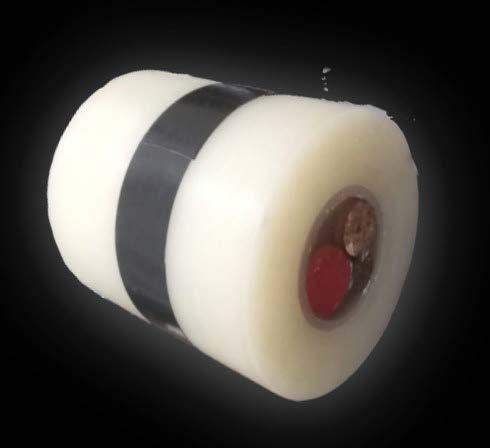
In line with the research proposal, ensuring the standardization of CT protocols in Sri Lanka with respect to the protocols in the United States is imperative. To achieve this goal, I traveled to the USA to conduct CT scans of the homemade radiomic phantom. To secure financial support, I sought guidance from Prof. Wijesooriya, who recommended exploring the AAPM GREMP Program. Following our application, which included interviews and presentations, I was fortunate to be selected as one of

the three candidates for the GREMP 2022-2023 cycle. The acknowledgment of receiving this esteemed grant from AAPM as a Sri Lankan researcher fills me with immense pride and honor. Quan Chen, PhD, served as my AAPM GREMP Program mentor.
During my visit to the USA in March 2023, I first traveled to the City of Hope Cancer Center and Research Institute in Duarte, CA, where I collaborated with Prof. Quan Chen. While collecting data for my research, I had the invaluable opportunity to enhance my programming skills
using PyRadiomics and to adapt Python scripts under Prof. Quan's guidance.
Subsequently, I visited the University of Virginia in Charlottesville, VA, where I engaged in various activities. I actively participated in scanning radiomic phantoms alongside Radiology Physicist, Patricia Collins, PhD, and therapists using different CT scanners. Additionally, I attended grand rounds presentations, took part in physicsguided readings, and benefited from listening to motion management presentations conducted by resident medical physicists.
I was involved in the MDACC credentialing process for IMRT H&N phantom irradiation, including IGRT and absolute output measurements, led by Prof. Wijesooriya and her team. This gave me an insight into the credentialing activities we need to perform in Sri Lanka prior to initiating the clinical trial we plan to perform. I also gained insight into the physics behind annual quality assurance (QA) activities on TrueBeam machines and gained exposure to the physics behind Gamma Knife treatments, QA under the mentorship of David Schlesinger, PhD.
I presented a poster entitled "Creating Radiomics Phantoms from Locally Available Materials for MultiInstitutional Evaluation of CT Radiomics in Sri Lanka" at the AAPM 65th Annual General Meeting and Exhibition held in Houston, Texas in 2023, with support from GREMP. Prior to this, I had the opportunity to showcase my work at the GREMP 2022 Symposium, which was an enriching experience of knowledge exchange among fellow GREMP participants. Receiving the GREMP grant has significantly transformed my career trajectory, opening up new avenues for growth and professional development.
The next step of my study aims to evaluate CT images of patients with HNSCC who have already undergone treatment to characterize and classify tumors using radiomic features with machine learning. Then studies will be conducted at different oncology clinics in Sri Lanka and will predict treatment efficiency in H&N cancer. Finally, the radiomics data will be compared with other ethnic groups, such as Caucasians and African Americans.
This work has spurred the interest of Radiation Oncologist, Dr. Jayakumaran. We have submitted and received approval from the IRB to conduct a clinical trial to evaluate
40 | www.aapm.org AAPM Newsletter | May/June 2024 Volume 49, No. 3
Homemade Radiomics Phantom
With Professor Quan Chen
AAPM GLOAL RESEARCH MENTORSHIP PROGRAM (GREMP) REPORT , Cont.
the patient tumor radiomic features and overall survival in H&N cancer.
Given the fact that disproportionally less research is being done in LMICs as shown in an analysis by Wells et al. (2021) which shows that only 8% of global oncology randomized clinical trials (RCTs) were led by investigators from LMICs,

we think this is a step towards the right direction initiated by the AAPM GREMP funding. ¢
Reference: Wells, J. C. et al. An analysis of contemporary oncology randomized clinical trials from low/middle-income vs high-income countries. JAMA Oncol 7, 379–385 (2021).

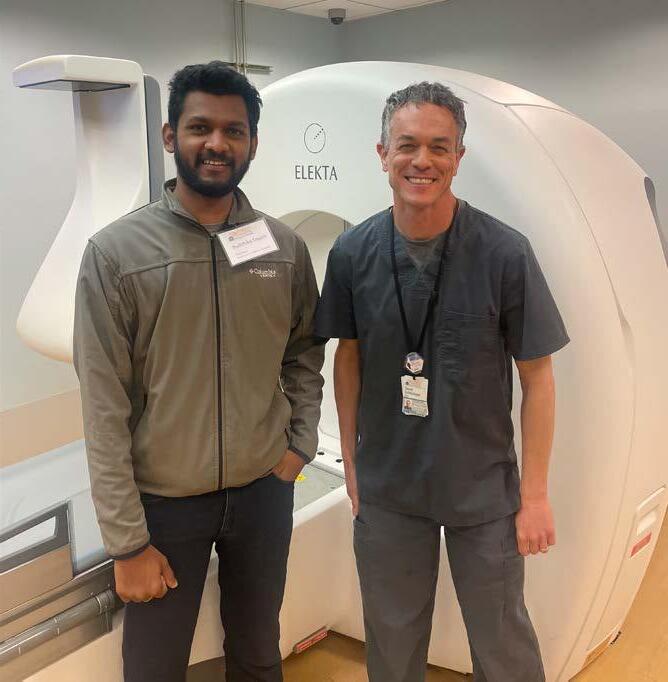
www.aapm.org | 41 AAPM Newsletter | May/June 2024 Volume 49, No. 3
Scan Radiomics Phantom at COH with Professor Quan and at UVA with Professor Wijesooriya With Professor David

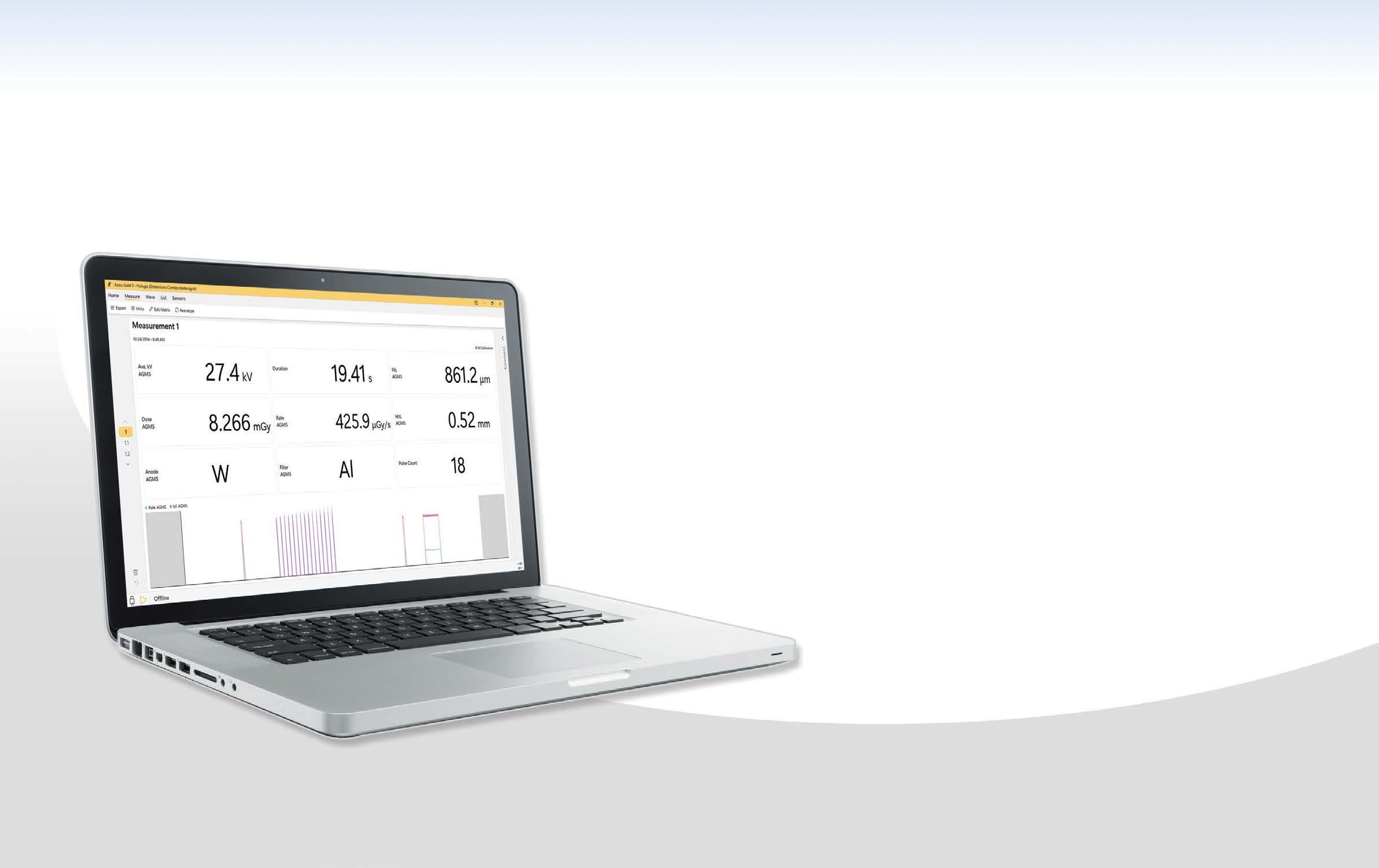


For further details: Contact us at +1 (626) 357-7921 • sales@radcal.com or www.radcal.com Visit us at CRCPD #123 5/20-5/24, Jacksonville, FL Accu-Gold 3 • Optimize Work Time – Machine Specific Profiles – Favorites Folder – Advanced Mammography: Single Exposure Combo-mode – Advanced CBCT Dental: Simultaneous DAP, kV and Dose • More Values Displayed New X-ray QA SOFTWARE vc AAPM Clr Ad 7.5x4.875_24Mar29.pdf 1 3/12/24 2:03 PM
M Mahesh selected to give the Villforth Lecture at the CRCPD Annual Meeting
PERSON IN THE NEWS
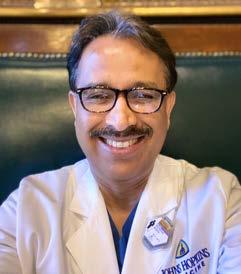
This year, the Annual Meeting of the Conference of Radiation Control Program Directors (CRCPD) will be held from May 20–23 in Jacksonville, FL. One highlight of the Annual Meeting is the John C. Villforth Lecture, held during the opening session of the meeting. The lecture was inaugurated in 2001 to honor Rear Admiral John C. Villforth, who served in the US federal government for over 30 years in various capacities, including as Director of the FDA’s Bureau of Radiological Health (1969-1982) and Center for Devices and Radiological Health (19821990), and as a member of the National Council on Radiation Protection and Measurements (NCRP) from 1971-1982. The named lecture pays tribute to Mr. Villforth for his steadfast support of state radiation control agencies and recognition of their contributions to the success of national programs to protect the public health of citizens. Two AAPM Presidents have given prior Villforth Lectures, namely Melissa Martin, MS (Villforth Lecture, 2008; AAPM President, 2017) and Bruce Thomadsen, PhD (Villforth Lecture, 2015; AAPM President, 2018). This year, the CRCPD selected M Mahesh, PhD, AAPM President-Elect, to give the Villforth Lecture. AAPM congratulates Dr. Mahesh on this well-deserved recognition of his impact on the field of radiation protection. ¢

www.aapm.org | 43 AAPM Newsletter | May/June 2024 Volume 49, No. 3
Jennifer Pursley, PhD Massachusetts General Hospital
M Mahesh, PhD
Working Group on Grand Challenges 2024
Do you know an important, unsolved medical physics scientific issue?
Let AAPM's Working Group on Grand Challenges (WGGC) help you organize a Grand Challenge, an engaging way to address scientific dilemmas while connecting with the AAPM membership and the broader medical physics research community!
Call for GRAND CHALLENGE Proposals
WGGC is dedicated to promoting Grand Challenges focused on enhancing medical imaging in diagnostic and therapeutic applications. We're currently welcoming proposals from groups interested in hosting a Challenge ahead of the 2025 Annual Meeting. Selected proposals will receive sponsorship, including some financial support, and guidance from WGGC to facilitate successful execution. Don't miss this opportunity to make an impact! Learn more and find the proposal application form here.
Please e-mail proposals to Emily Townley (emily@aapm.org) by 5:00 PM EDT on Monday, July 8, 2024.

Register for these events at https://aapm.me/webinars
MAY 9
12:00–1:00 PM|ET
MAY 23
12:00–1:00 PM|ET
JUNE 6
12:00–2:00 PM|ET
JUNE 27
12:00–1:00 PM|ET
Webinar Series on Advances in Medical Physics
Webinar #37: Enabling Digital Twins for Predictive Oncology
Speaker: Deng
Webinar Series on MP3.0 Transformational Medical Physics
Episode #21: Radiation Oncology Journey: From Practice to Entrepreneurship
Speaker: Zankowski
Global Research and Scientific Innovation Committee: School on Research Excellence
Open Source Artificial Intelligence and Machine
Learning Tools for Medical Physics Applications
Speakers: Chlap, Xing, Liu
Pediatric Dual Energy CT Do's and Don'ts
Speakers: Zhang, Carver, Artz
UPCOMING WEBINARS

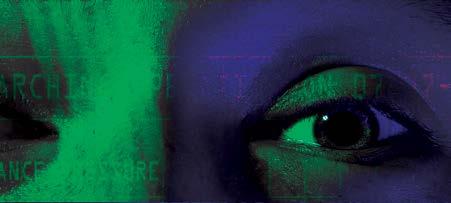




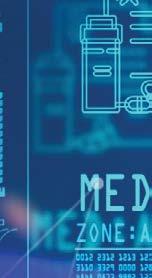
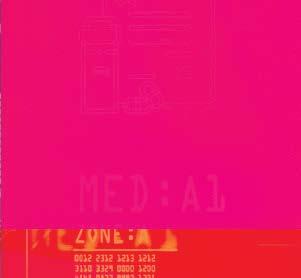



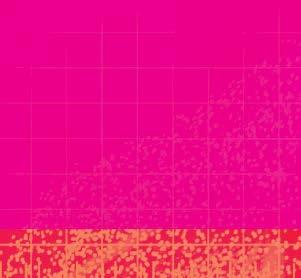
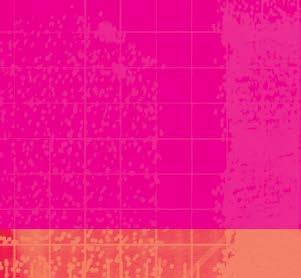

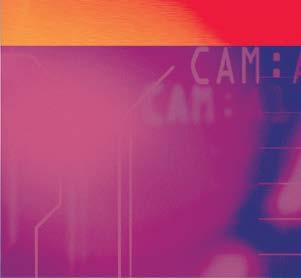



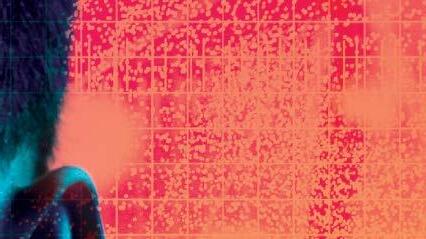



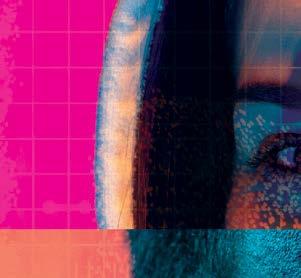






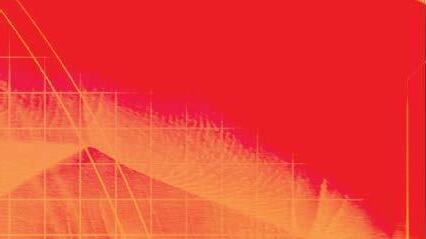


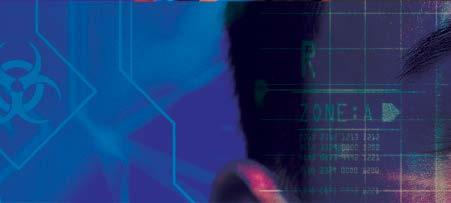





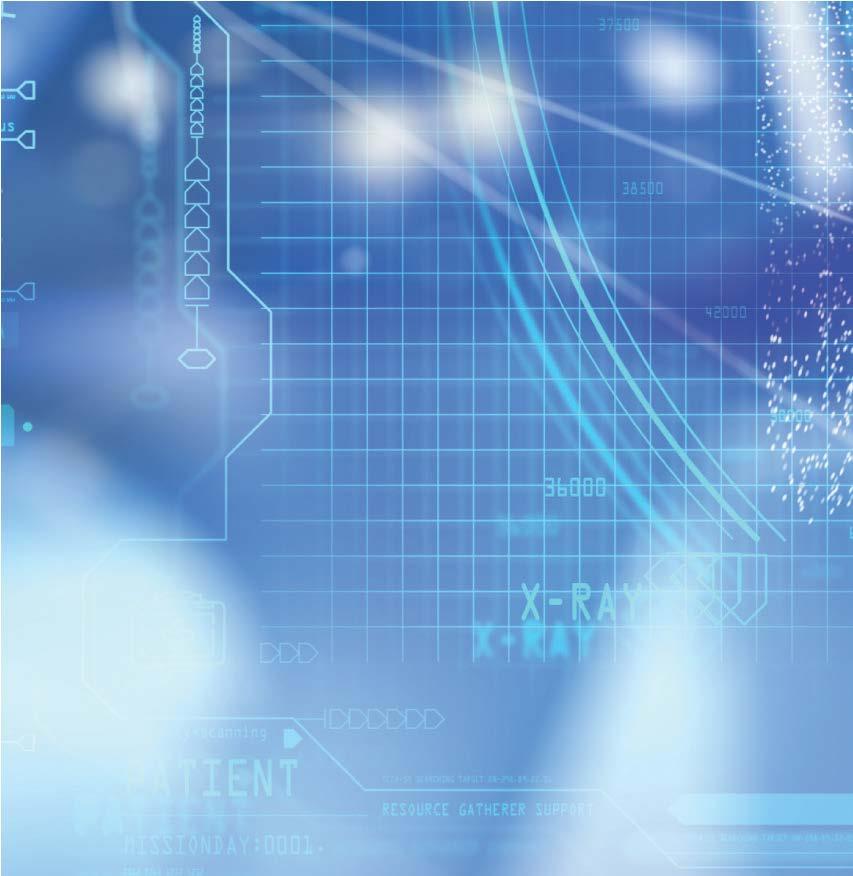







AAPM CAREER SERVICES CONNECTING medical physicists with the finest JOBS Find your future at aapm.org/careers
1631 Prince Street, Alexandria, VA 22314 | p. 571-298-1300 • f. 571-298-1301 | aapm.org















 Jennifer Pursley, PhD
Jennifer Pursley, PhD






 C. David Gammel Executive Director, AAPM HQ
C. David Gammel Executive Director, AAPM HQ
 David Crowley Senior Government Relations Manager, AAPM HQ
David Crowley Senior Government Relations Manager, AAPM HQ



 Dustin A. Gress, MS
Senior Advisor for Medical Physics
Dustin A. Gress, MS
Senior Advisor for Medical Physics















 Mariela A. Porras-Chaverri, PhD
Mariela A. Porras-Chaverri, PhD































 Jing Qian, PhD Mayo Clinic
Richard S. Dargan Contributing Writer, AAPM
Jing Qian, PhD Mayo Clinic
Richard S. Dargan Contributing Writer, AAPM





 Buddhika Srimal Sesath, PhD Candidate
Buddhika Srimal Sesath, PhD Candidate























































